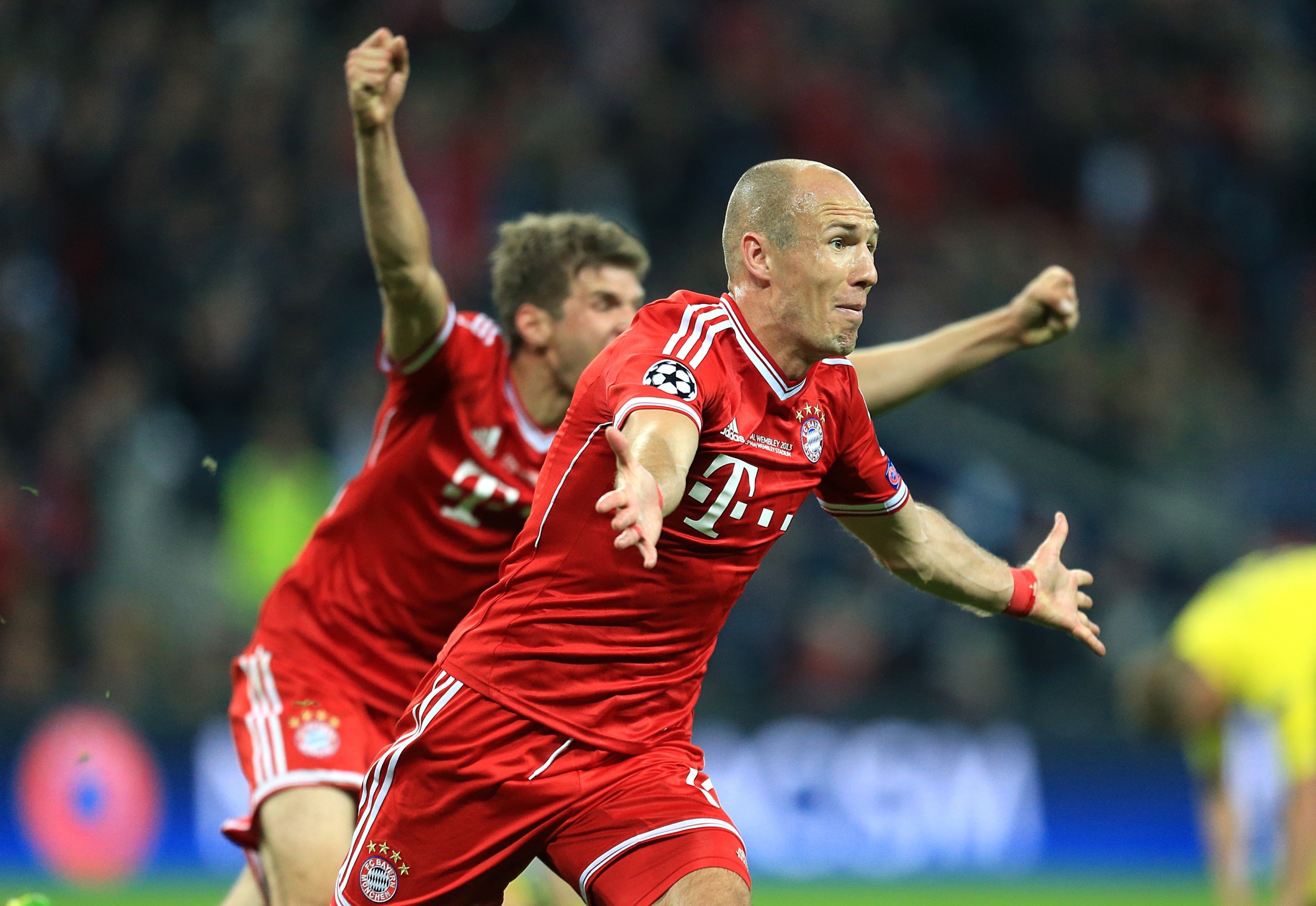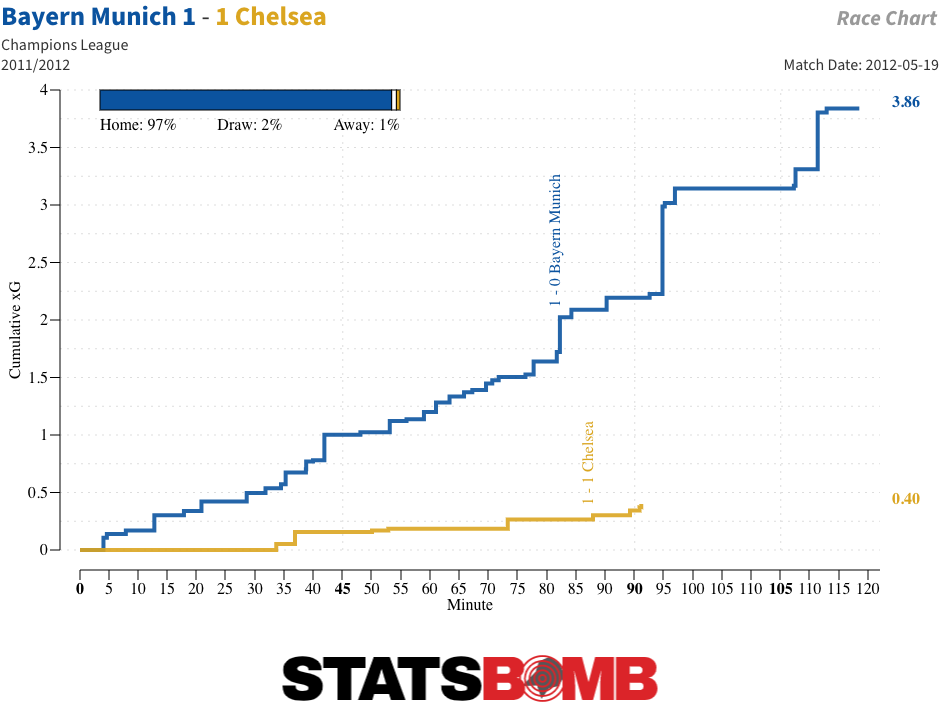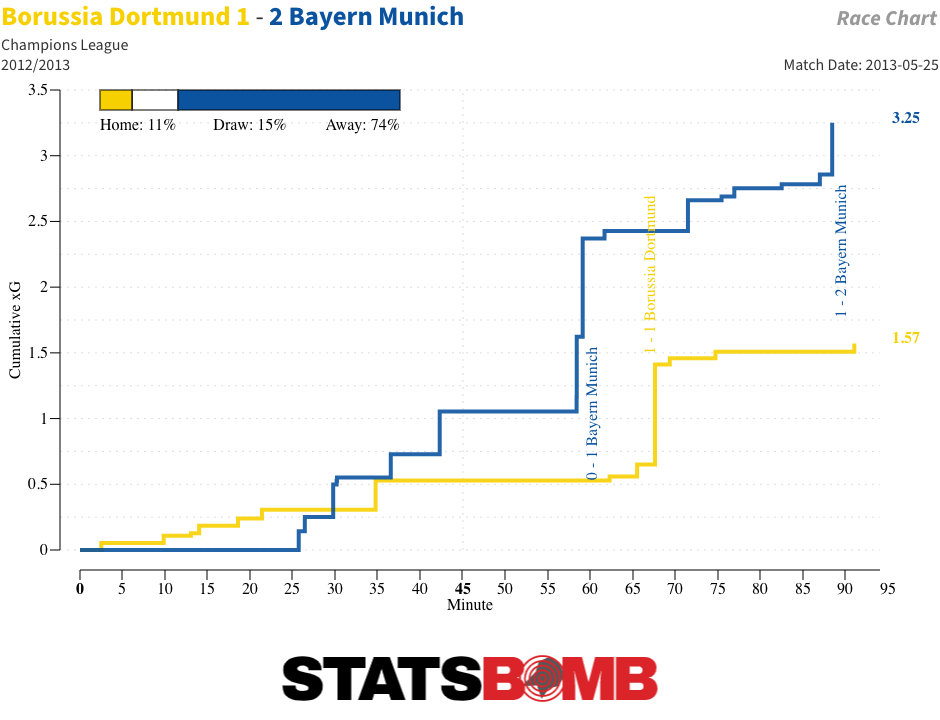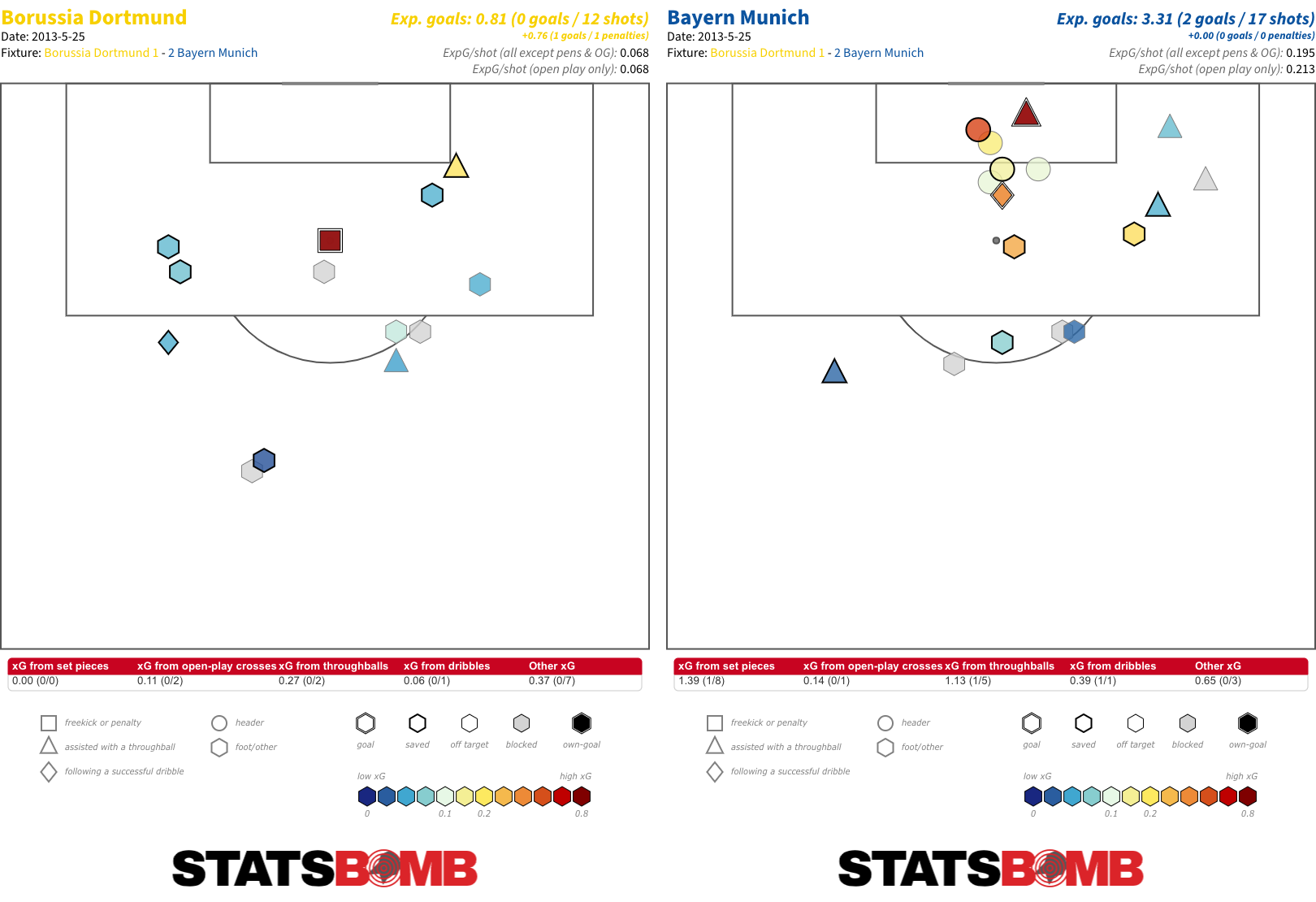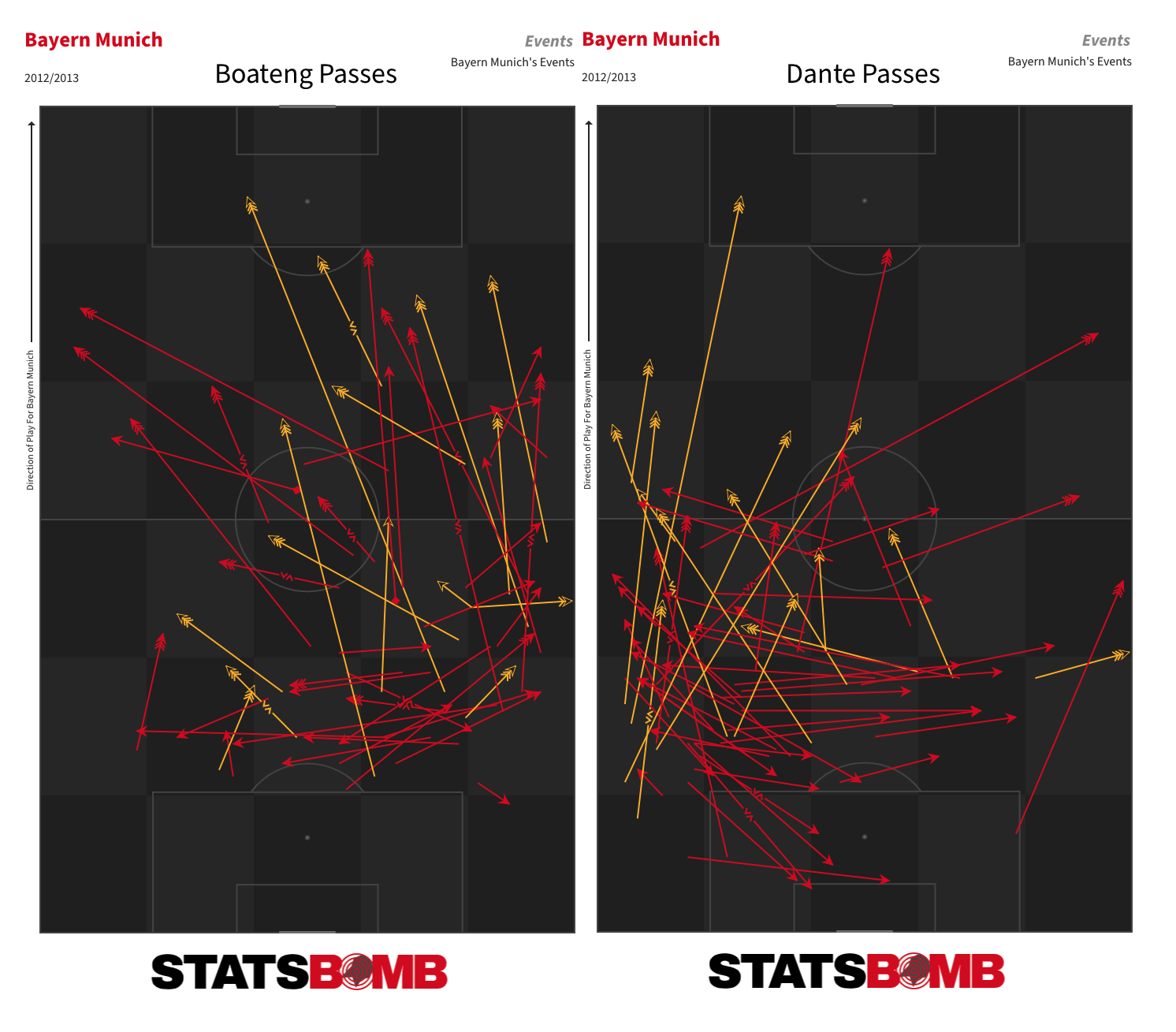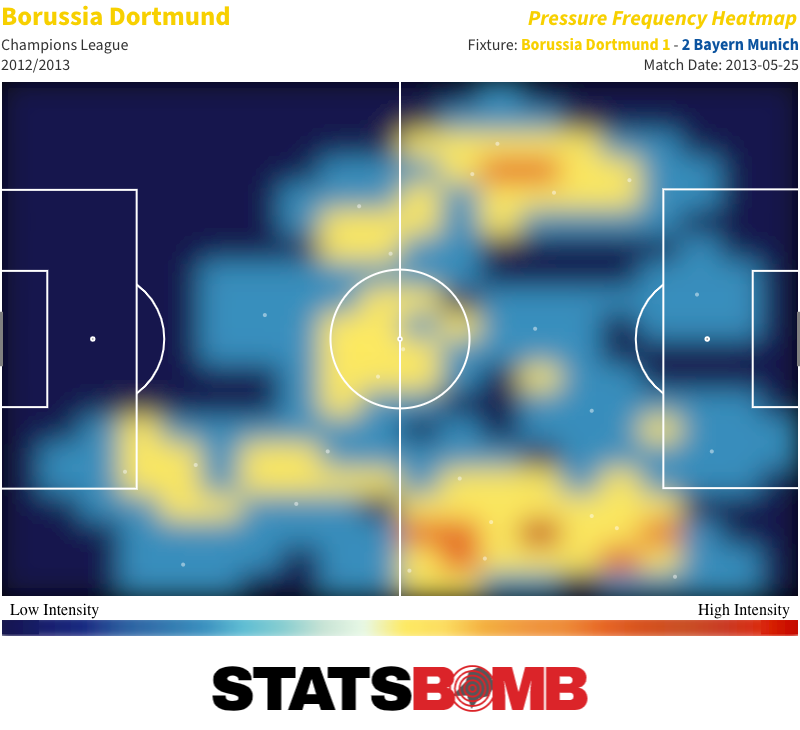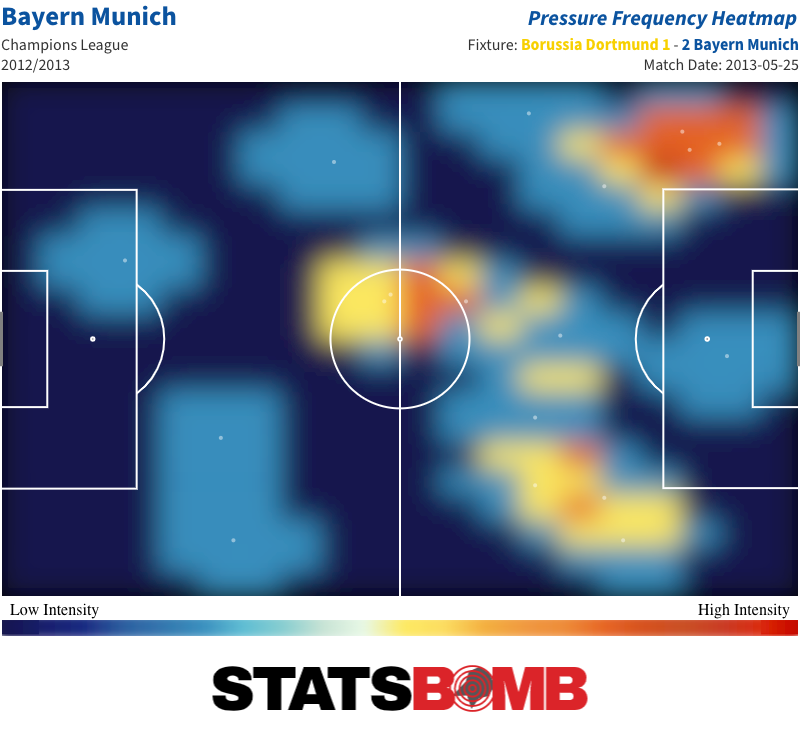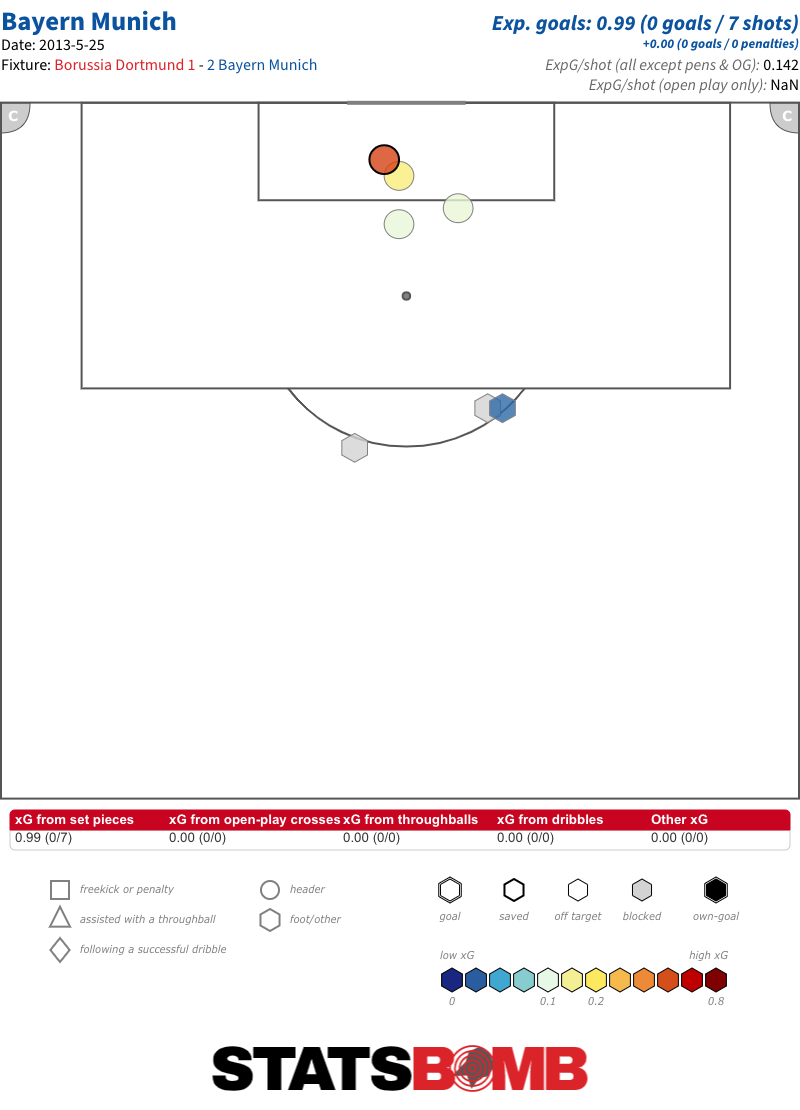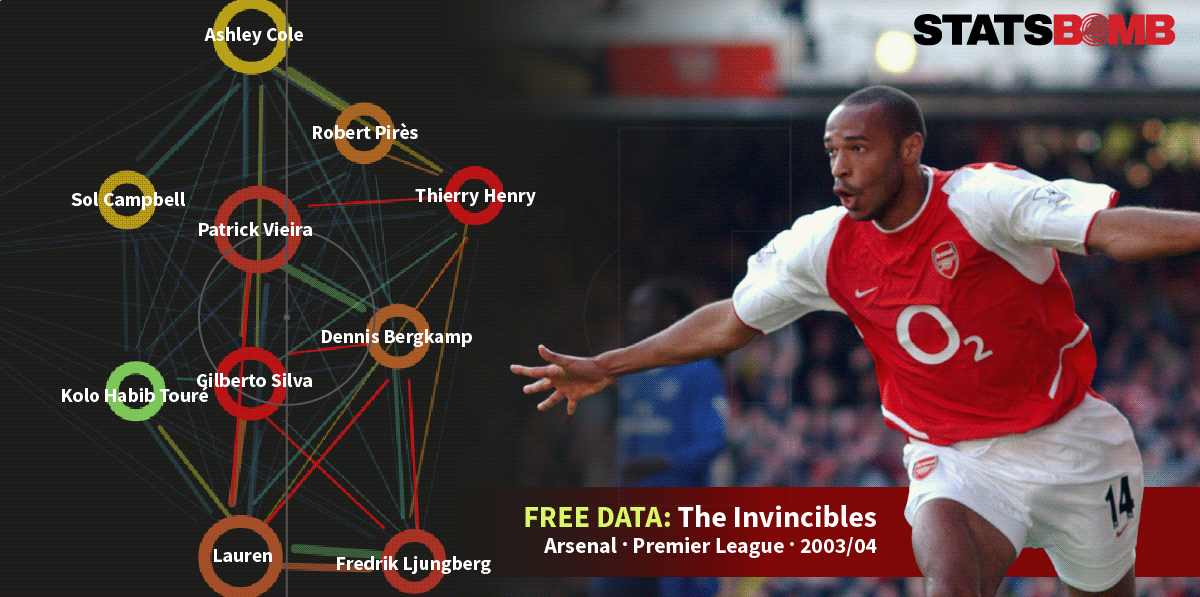A historic Bundesliga season is in the books. As Germany’s top-flight managed to restart the season after the coronavirus-induced break sooner than the Premier League and La Liga, it experienced how the new environment affects the game earlier than others.
The Bundesliga staged nine matchdays under unusual precautions, most notably the banning of fans from the stadiums. It quickly became clear that--at least in this league--the home-field advantage was reduced when there weren’t tens of thousands cheering the team although this development has been overstated. In total, 37 out of 82 matches (81 matches on nine regular matchdays plus one match that was postponed before the break) were won by the away side, with nine of these wins for the underdog according to the standings. For comparison, we saw only 27 wins in the 80 matches on the nine matchdays before the break, including five underdog wins.
The empty stands undeniably affected the football played on the pitch. There’s a point to be made that football is less consequential when no one – besides the coaching staff and a handful of bench players – is reacting to success and failure. Especially early after the break, several Bundesliga players were keen to show that they can escape situations with elegance instead of brute force. This resulted in pressing attacks being outmanoeuvred with dribbles and smart movements while in normal times the long hoof might have been the typical reaction from defenders that don’t possess the best feet.
But that’s just anecdotal. Let’s look at some of the numbers that indicate the various effects of the different environment in what Germans call Geisterspiele (ghost games). We compare the nine matchdays after the break with the nine before, starting on 20 December 2019.
Less intensity
The eye test suggested early on that teams were less intense, particularly in advanced positions defending against the build-up of the opponents. The high press has been a prominent feature of Bundesliga football for several years. Centre-backs with bad feet often fell victim to this kind of style, while coaches of smaller clubs sometimes decided to abandon any kind of constructive build-up play for security concerns. While the pressures in the opposing half averaged around 77 per team per match before the break, it fell to 66 after it. This significant change certainly proves the eye test correct. What’s also striking is how many teams didn’t necessarily change their overall approach as the ranking among the Bundesliga clubs has remained largely the same, with two exceptions: Schalke, somewhat surprisingly, recorded the most pressures in the opposing half after the break which goes to show that the team did not give up in the midst of a crisis but rather were not able to capitalise on its intensity. Meanwhile, Borussia Dortmund dropped from second down to rock bottom which might give Lucien Favre’s critics some new fodder, as BVB were already third from last in this category before they lost to Mainz and Hoffenheim late in the season.
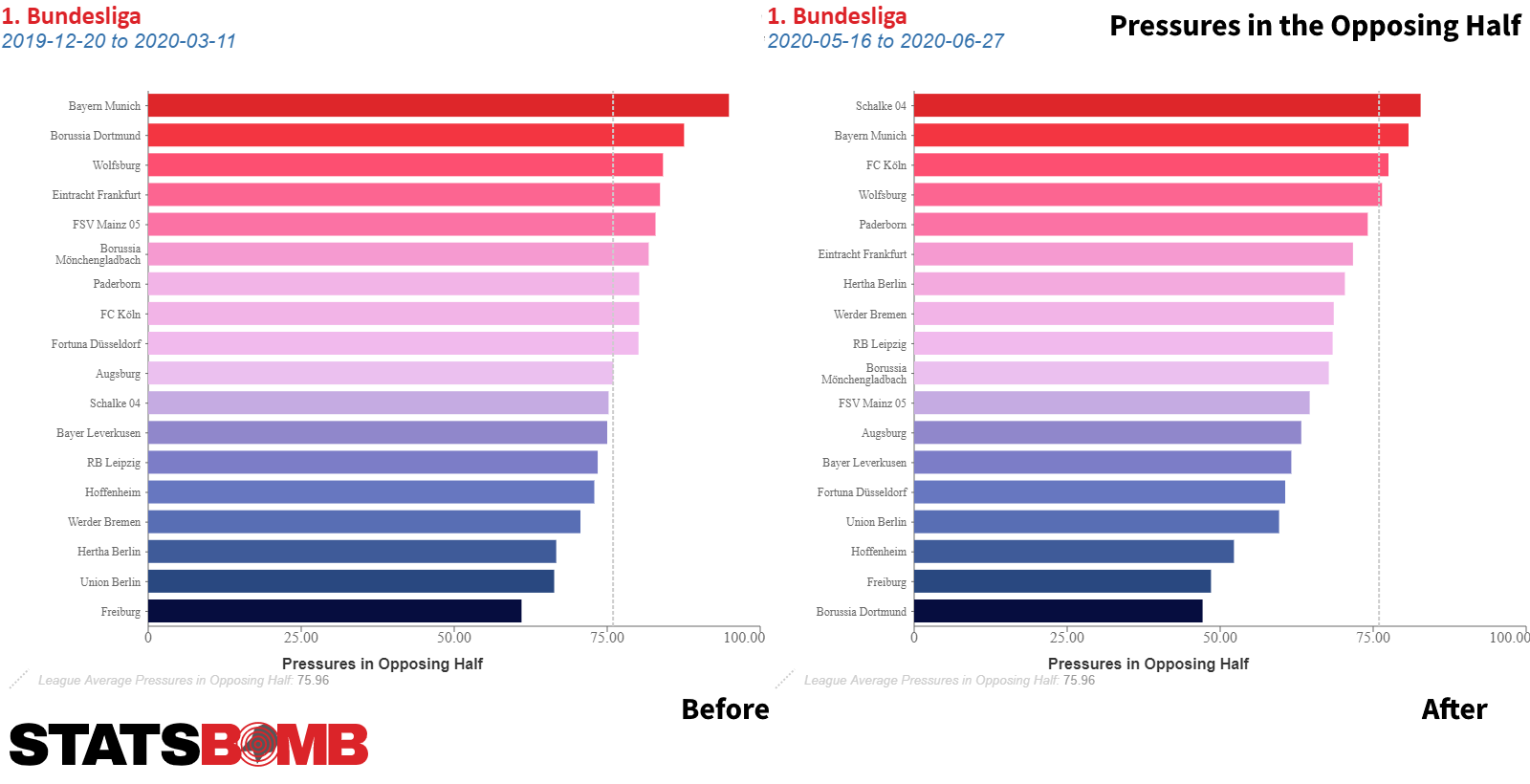
The number of counterpressures across the entire pitch also declined, falling from around 35 to 30 per team per match. Borussia Monchengladbach were outstanding in this category post-break, while Dortmund and Wolfsburg were less active immediately after turnovers.
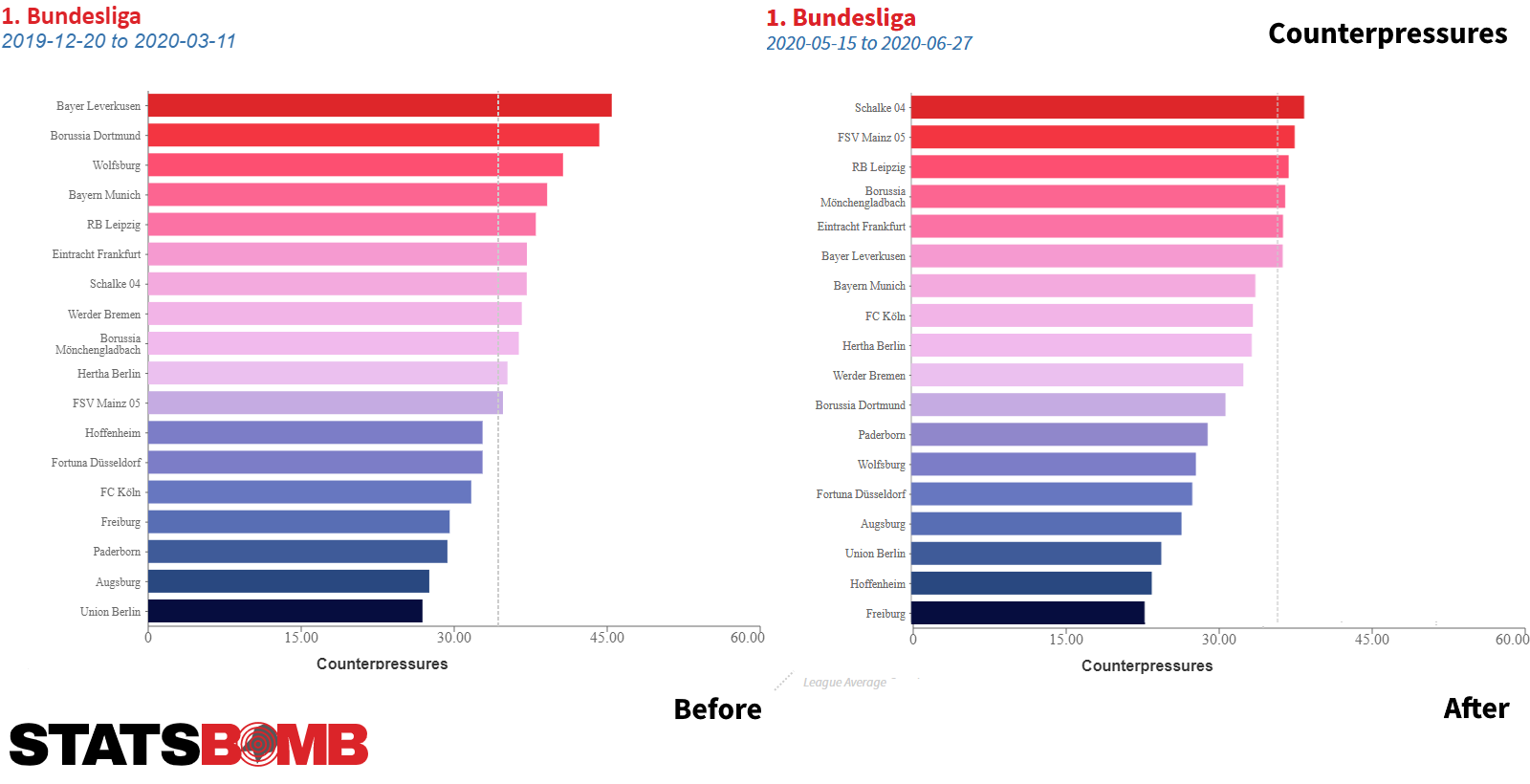
There are a few factors that contribute to these numbers, most importantly the unparalleled circumstances during and shortly after the break. Teams were not able to train as hard as they would have liked to for a couple of weeks, because close contact between players was not allowed. Hertha’s Bruno Labbadia and a few other head coaches stated how they could not practise any kind of intense pressing or just intense actions in general which hindered plans to bring their teams into a state where they could replicate or improve the effectiveness of pressing.
Moreover, the overall fitness level was likely below par when the Bundesliga returned on 16 May, but the tracking data provided through the Bundesliga indicated that teams were only running less and made fewer sprints on the first matchday post-break, and as time moved on, the numbers quickly approached pre-Corona levels.
No tactical changes
An instinctive response to these stats could be that coaches just adjusted the tactical setup of their teams to pay tribute to the circumstances. They accepted that their teams could not play such a high or even midfield press throughout the entirety of the match and instead settle for a more cautious style with a deeper back line and a more compact structure that would rely less on defensive actions and instead defend space more effectively.
However, the defensive distance, meaning the average distance from a team’s own goal from which they make defensive actions, remained almost the same, with a per-team average of 43.9 metres before and 44.9 metres after the break. It wasn't the case that suddenly a good portion of the league was sitting deep, hoping to keep opponents away from the goal. We also didn’t see a wave of tactical changes, as most coaches stuck to what they did before the break in terms of basic formations and the structures in all game phases.
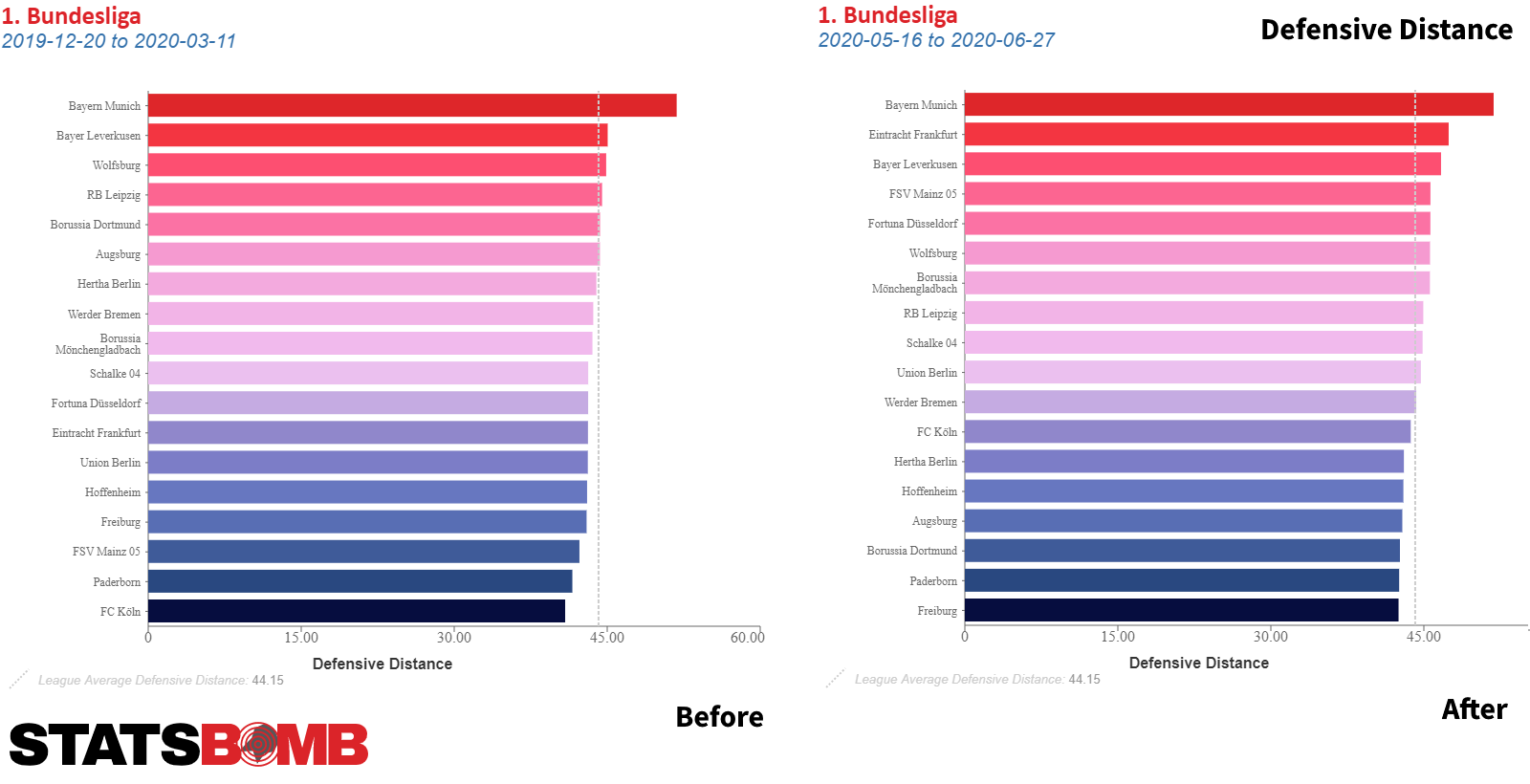
Higher xG
Less pressing coupled with no significant tactical changes could logically be considered to indicate a higher probability of scoring. Interestingly, on average, we saw fewer dribble attempts (17.3 compared to 18.3 per team per match) and fewer passes inside the box (2.4 compared to 2.7 before) but with a fairer distribution across the league. This indicates that it was easier for most of the teams to get close to the goal without having to rely on attacking actions that require outstanding individual skills. Instead, it was due to the declining resistance of opponents that teams were simply able to advance more easily.
The open play xG rose from an average of 1.06 to 1.13 per team per match. The average amount of shots per team per match, however, dropped from 13.12 to 12.32, with fewer shots resulting from a high press (3.0 to 2.5) and through counterattacks (1.3 to 1.1).
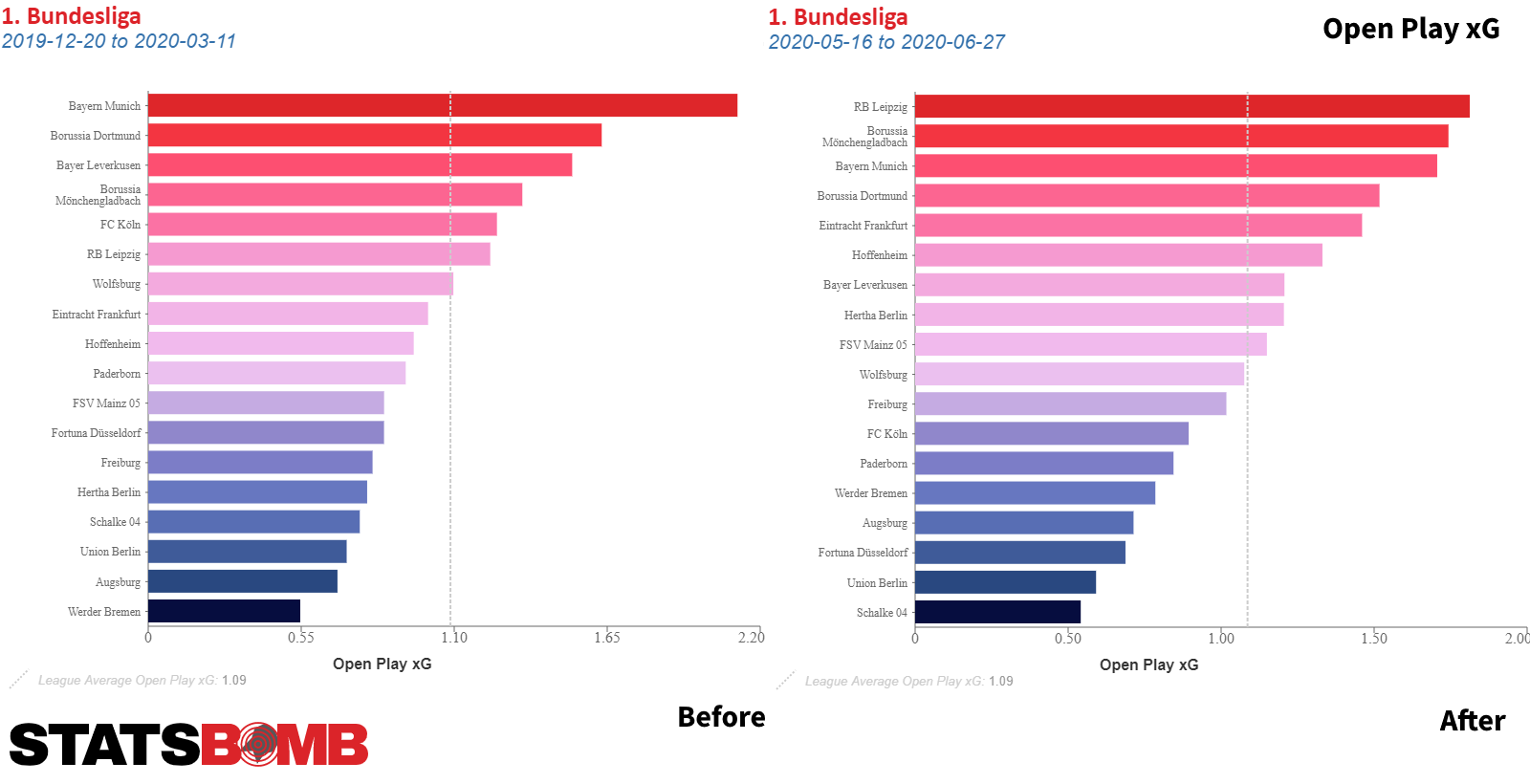
Overall, the attacking output did not increase, even though the decline in defensive intensity could have facilitated the output. What happened in the past few weeks was that there were fewer interactions between players, particularly in one-on-one duels, which allowed teams to play their way through defensive structures facing less resistance than usual. If the declining defensive resistance was caused from a lack of fans inspiring players to get physical, pressure opponents, and generate turnovers is just one factor in play during this period and is therefore up to debate, and a hypothesis that can perhaps never effectively be tested.
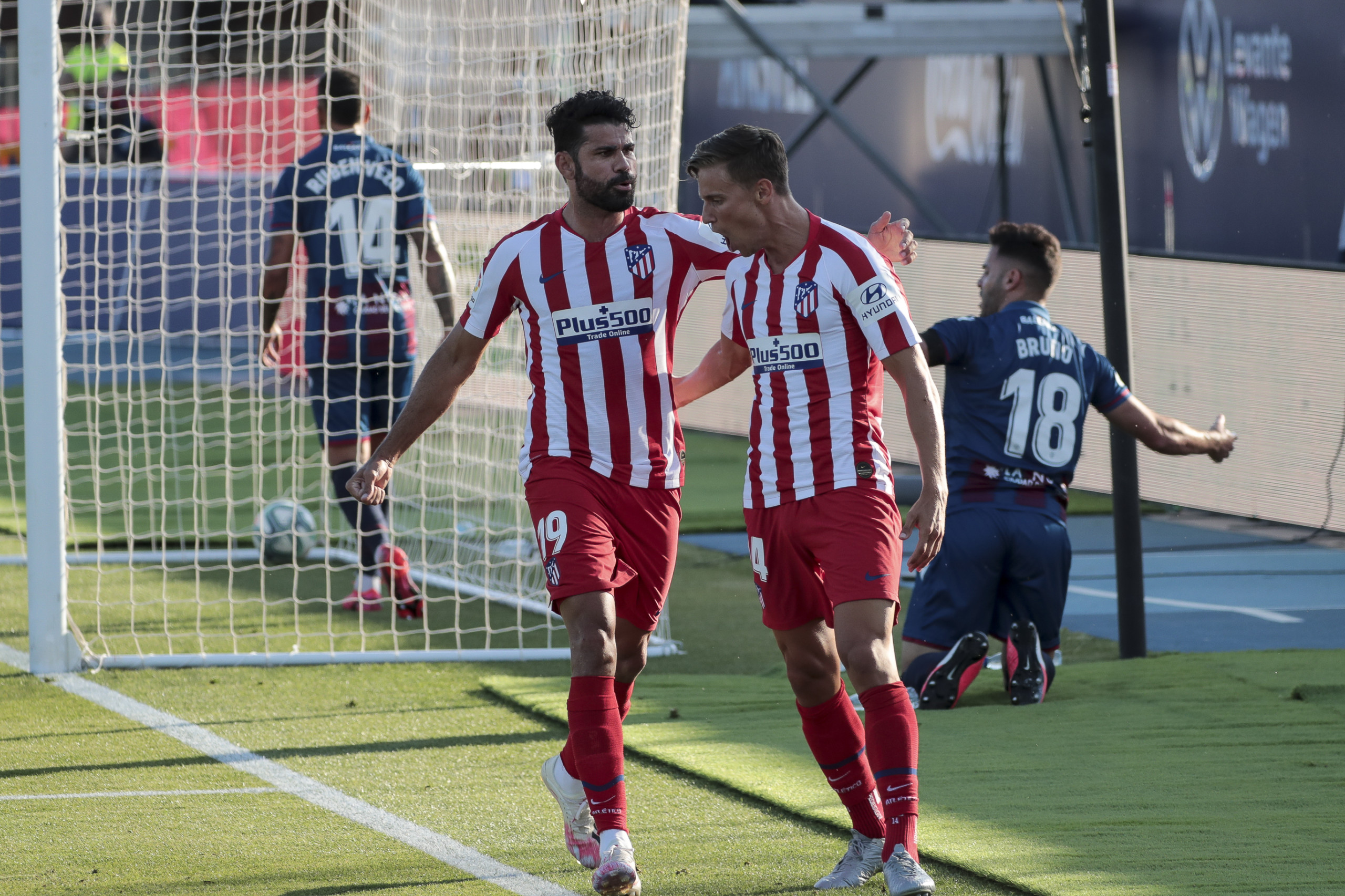

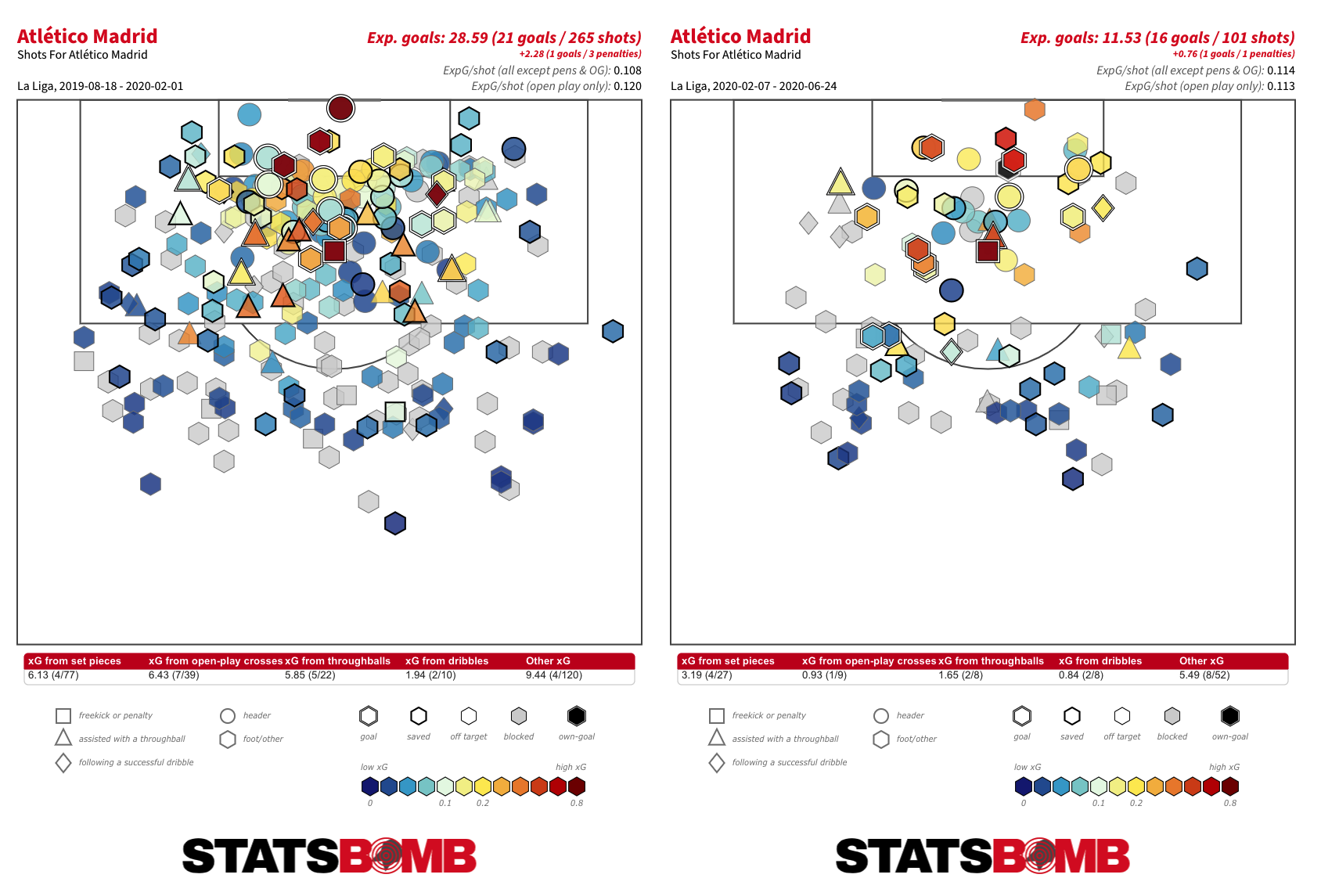
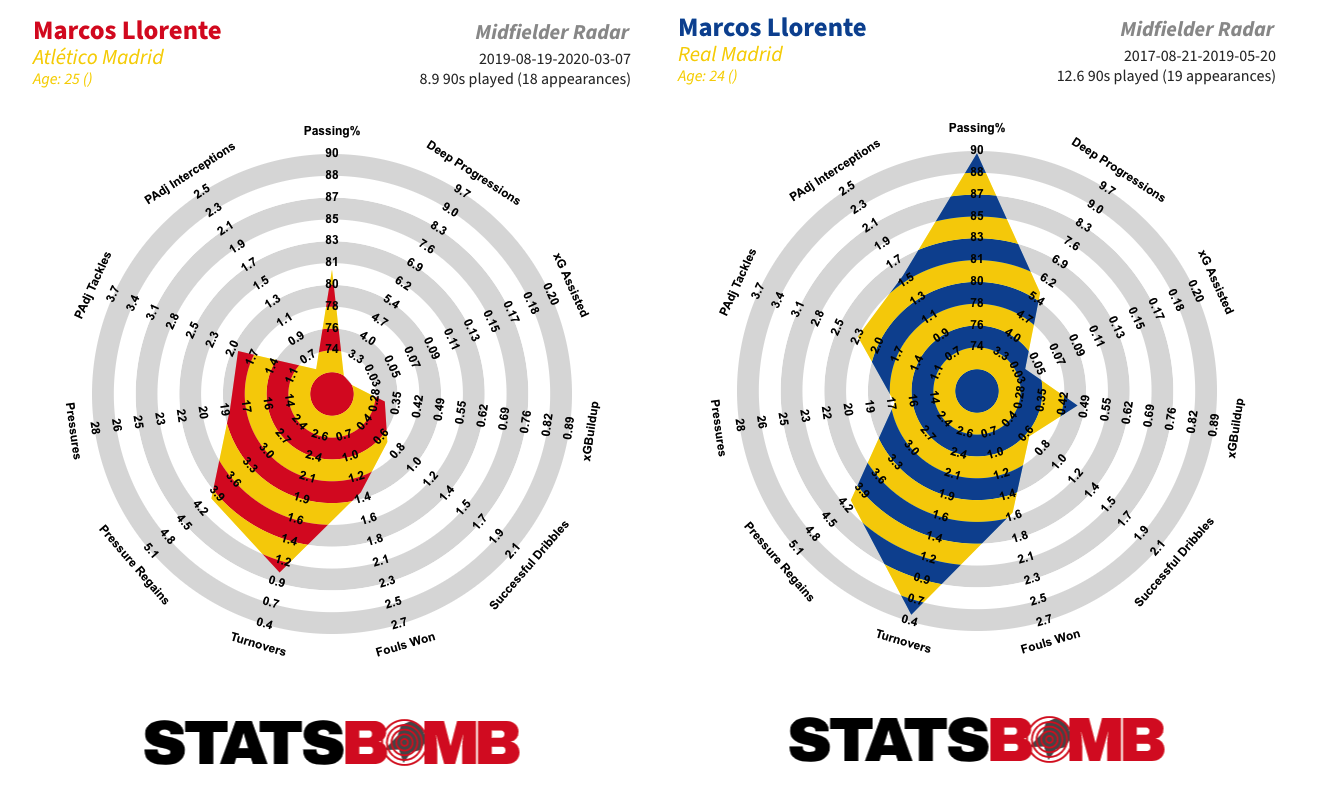
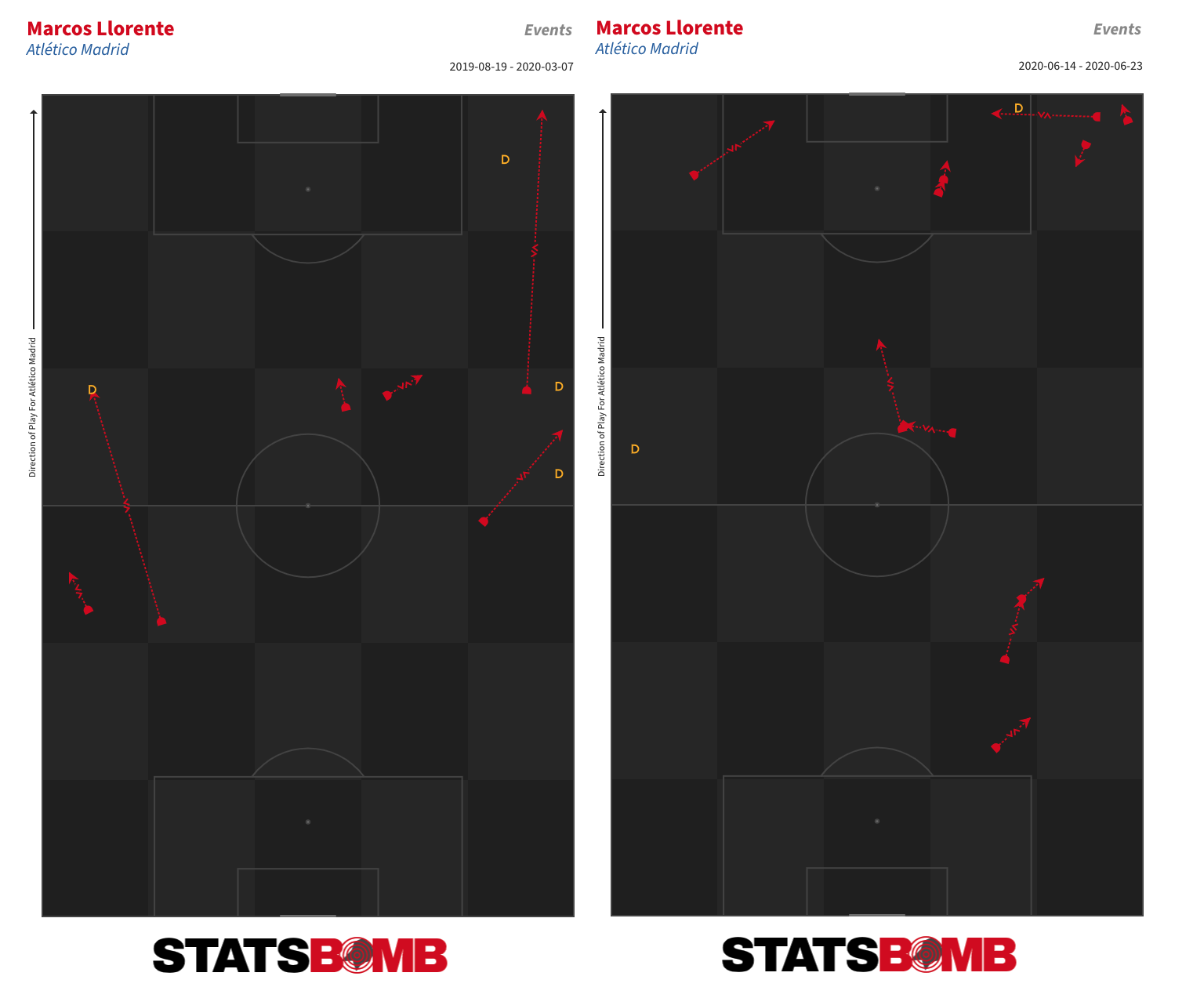
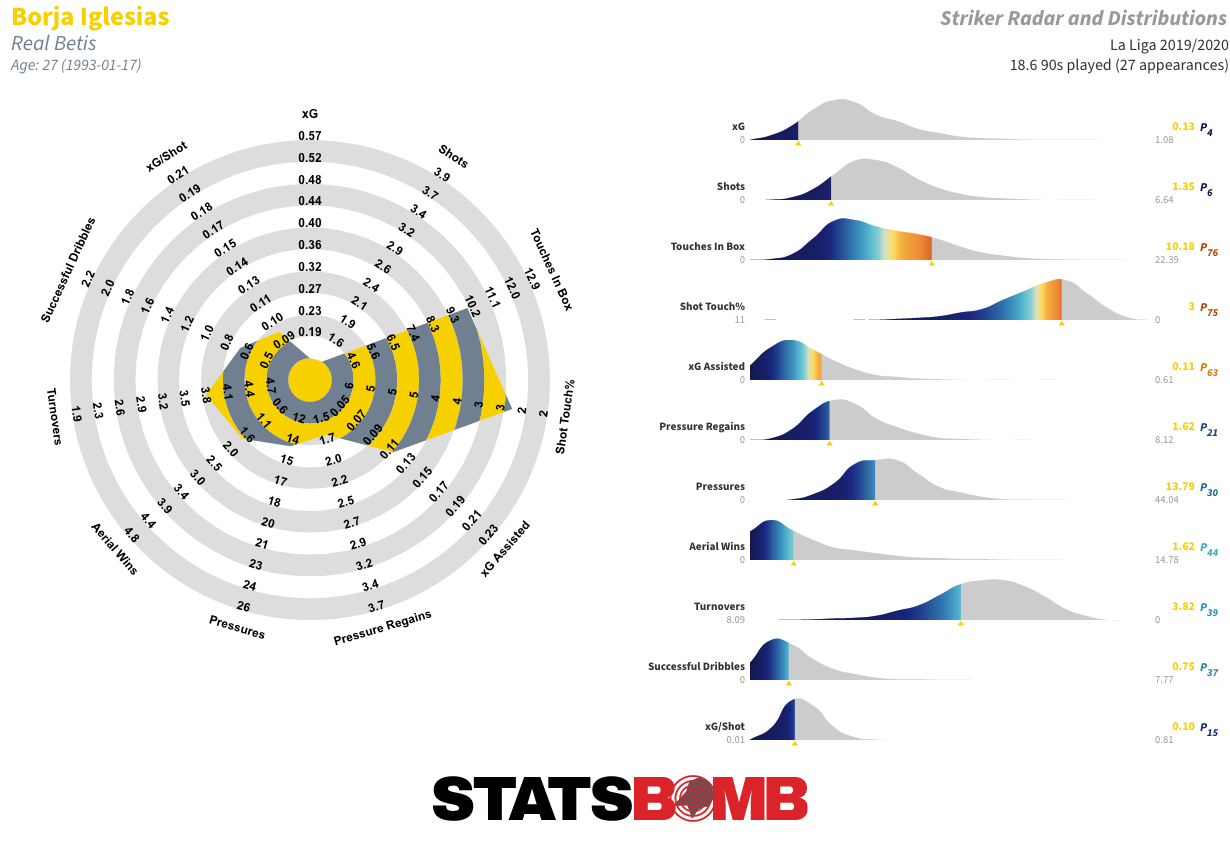
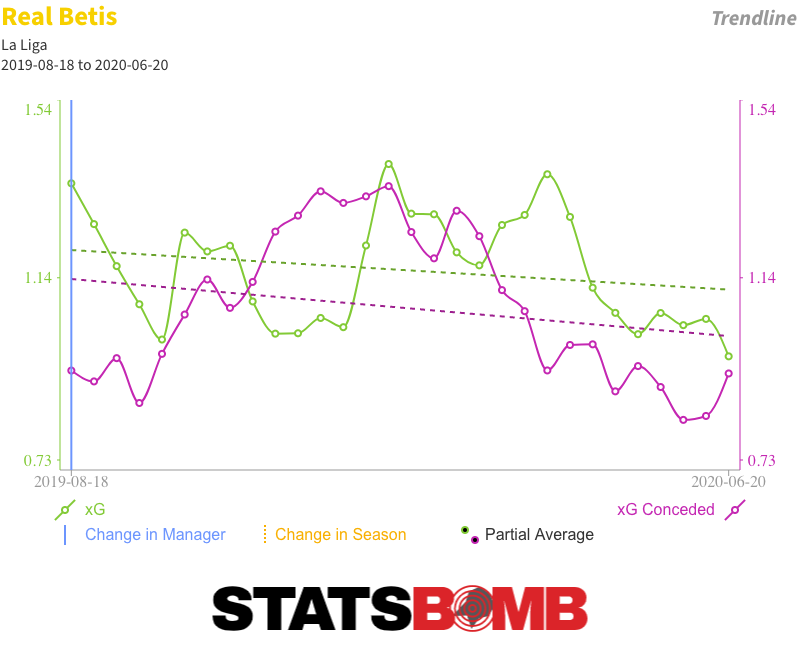
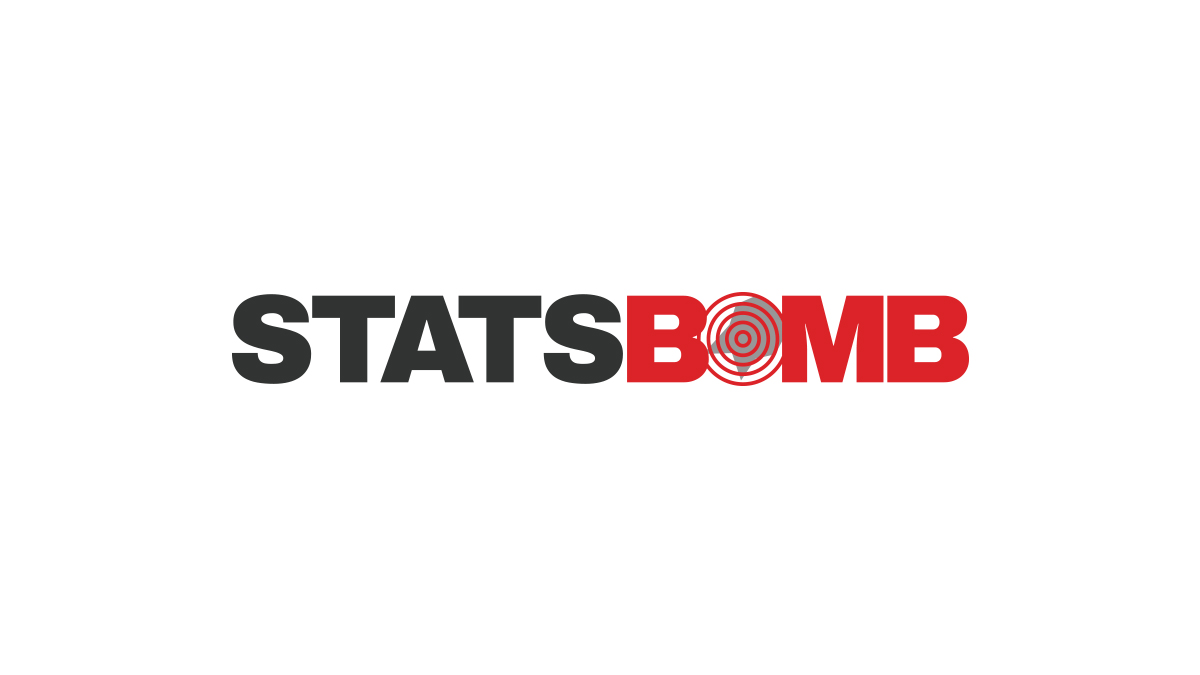
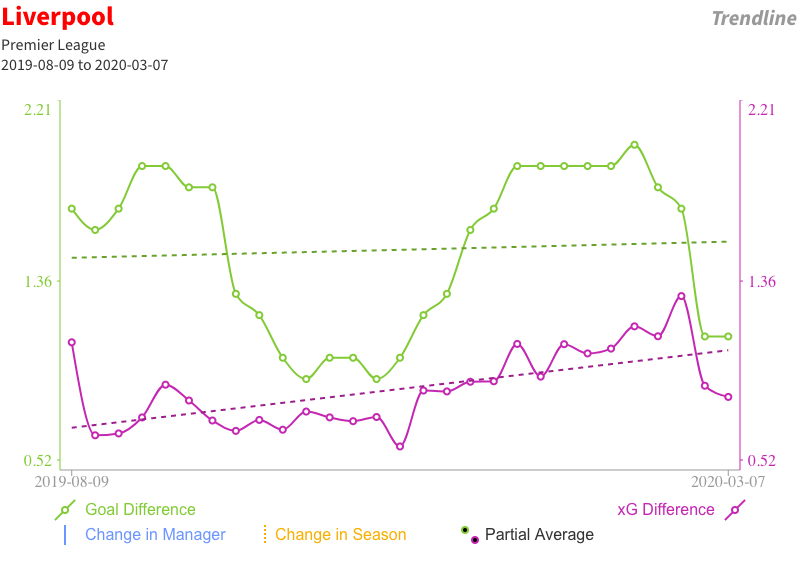
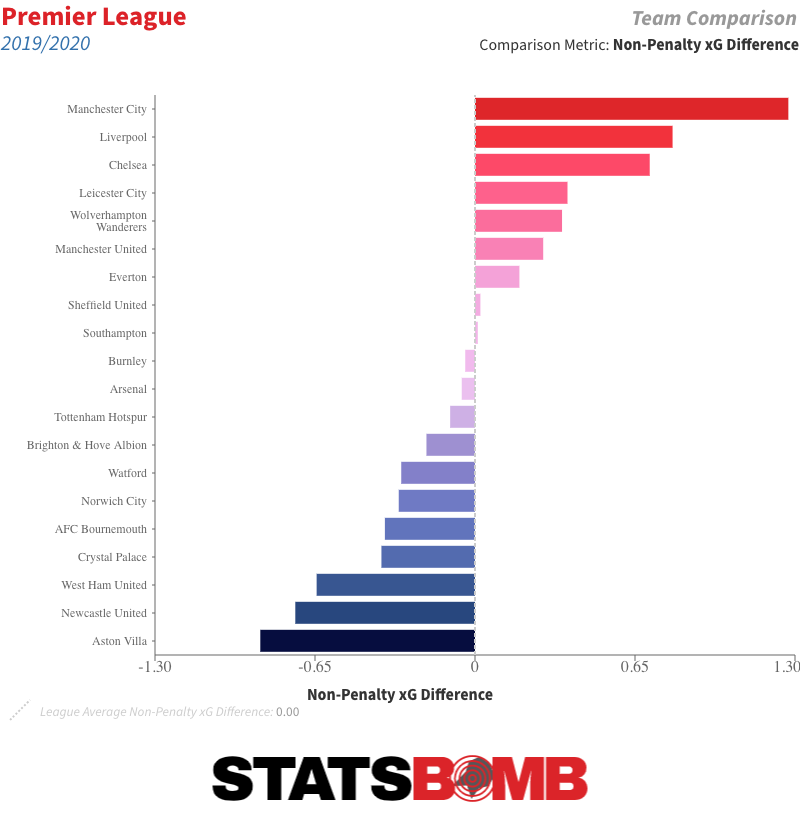 Manchester United and Wolverhampton Wanderers are separated by just two points, and are pretty much neck and neck on expected goal (xG) difference. The underlying numbers over the last 10 matches suggest the momentum is with Wolves...
Manchester United and Wolverhampton Wanderers are separated by just two points, and are pretty much neck and neck on expected goal (xG) difference. The underlying numbers over the last 10 matches suggest the momentum is with Wolves... 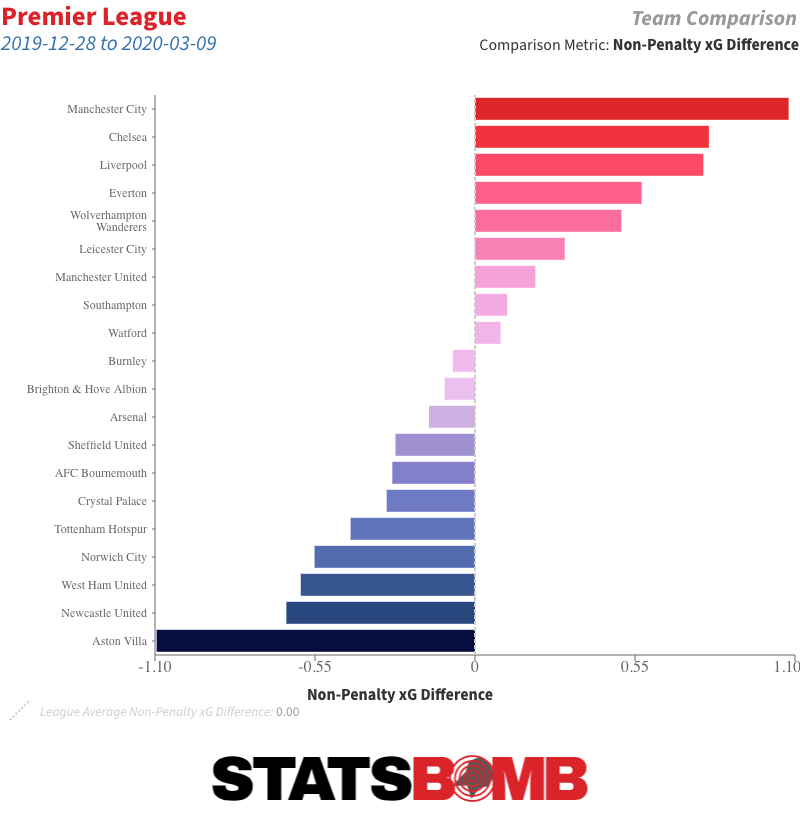 ...but it is United who have taken more points in that time: 17 to 13. These things often take much longer than nine matches to shake themselves out, especially when the differences are fairly minimal. United will also benefit from the return from injury of Marcus Rashford, their primary attacking contributor.
...but it is United who have taken more points in that time: 17 to 13. These things often take much longer than nine matches to shake themselves out, especially when the differences are fairly minimal. United will also benefit from the return from injury of Marcus Rashford, their primary attacking contributor. 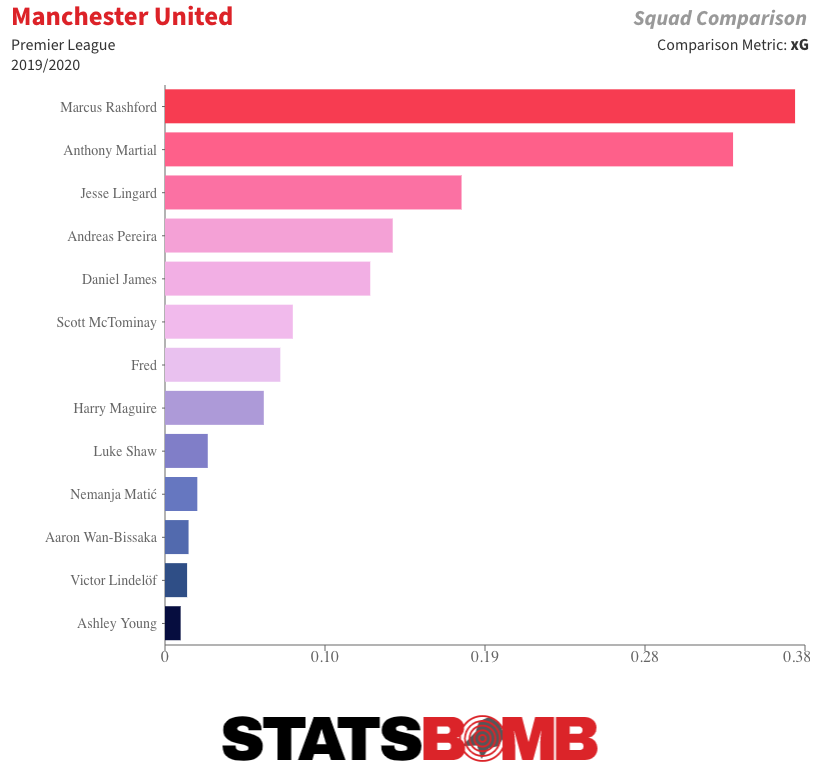 Tottenham Hotspur have also profited from the pause in action, as it has allowed them to recover some much-needed firepower in the form of Harry Kane and Heung-Min Son (as well as January recruit Steven Bergwijn).
Tottenham Hotspur have also profited from the pause in action, as it has allowed them to recover some much-needed firepower in the form of Harry Kane and Heung-Min Son (as well as January recruit Steven Bergwijn). 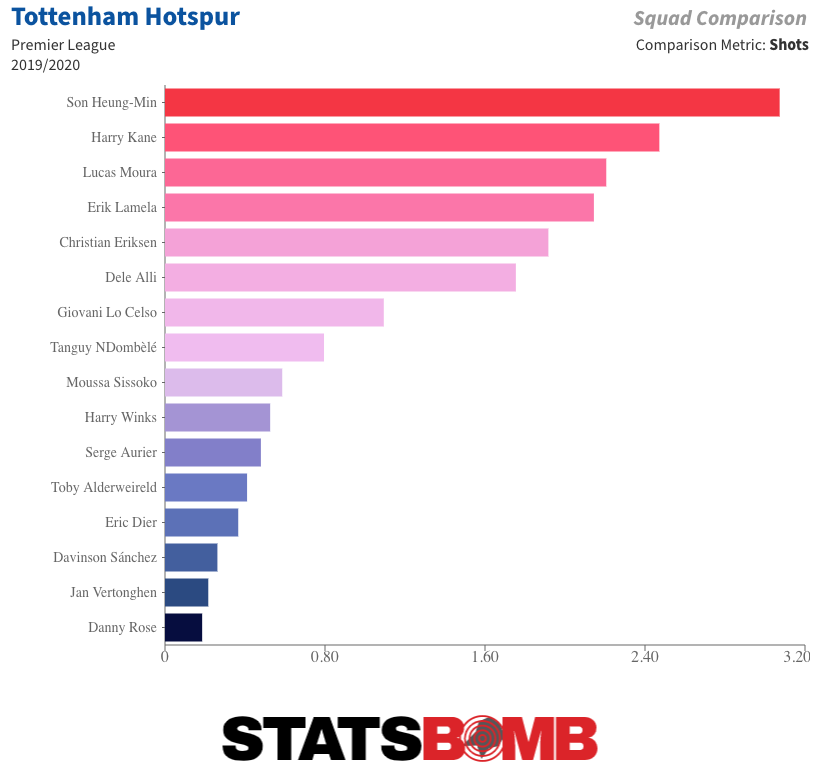 That alone is unlikely to turn things around for a side who after an initial surge under Jose Mourinho had combined mid-table results with downright sad underlying numbers in the lead up to the league stoppage, but it certainly won’t hurt their chances. Sheffield United are a couple of points ahead of Spurs and have a game in hand that if won would see them leapfrog United into fifth. They’ve already defied the odds by coming up and immediately establishing themselves as a very solid top-flight side, and while their numbers aren’t as good as those of some of the teams around them, they are still very much in the mix. Arsenal are at the back end of the group, and haven’t really shown enough
That alone is unlikely to turn things around for a side who after an initial surge under Jose Mourinho had combined mid-table results with downright sad underlying numbers in the lead up to the league stoppage, but it certainly won’t hurt their chances. Sheffield United are a couple of points ahead of Spurs and have a game in hand that if won would see them leapfrog United into fifth. They’ve already defied the odds by coming up and immediately establishing themselves as a very solid top-flight side, and while their numbers aren’t as good as those of some of the teams around them, they are still very much in the mix. Arsenal are at the back end of the group, and haven’t really shown enough 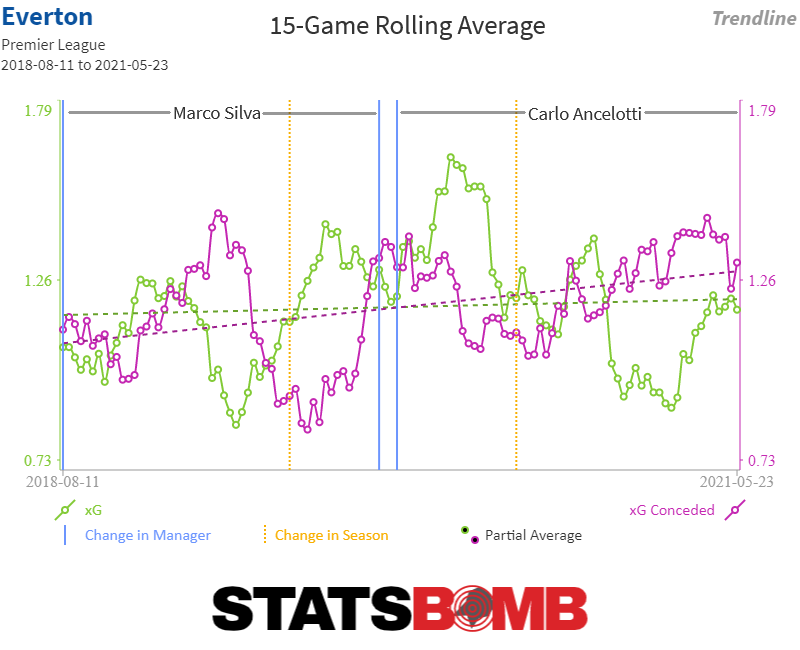 Relegation At the bottom of the table, there are probably six teams fighting to avoid filling the three relegation spots. Southampton, five points up the road from 15th placed Brighton and seven points clear of the bottom three, will likely be okay. [table id=84 /] Norwich are four points adrift at the bottom and it’s honestly difficult to see them making up the six points that separate them from safety. Their attempt to
Relegation At the bottom of the table, there are probably six teams fighting to avoid filling the three relegation spots. Southampton, five points up the road from 15th placed Brighton and seven points clear of the bottom three, will likely be okay. [table id=84 /] Norwich are four points adrift at the bottom and it’s honestly difficult to see them making up the six points that separate them from safety. Their attempt to 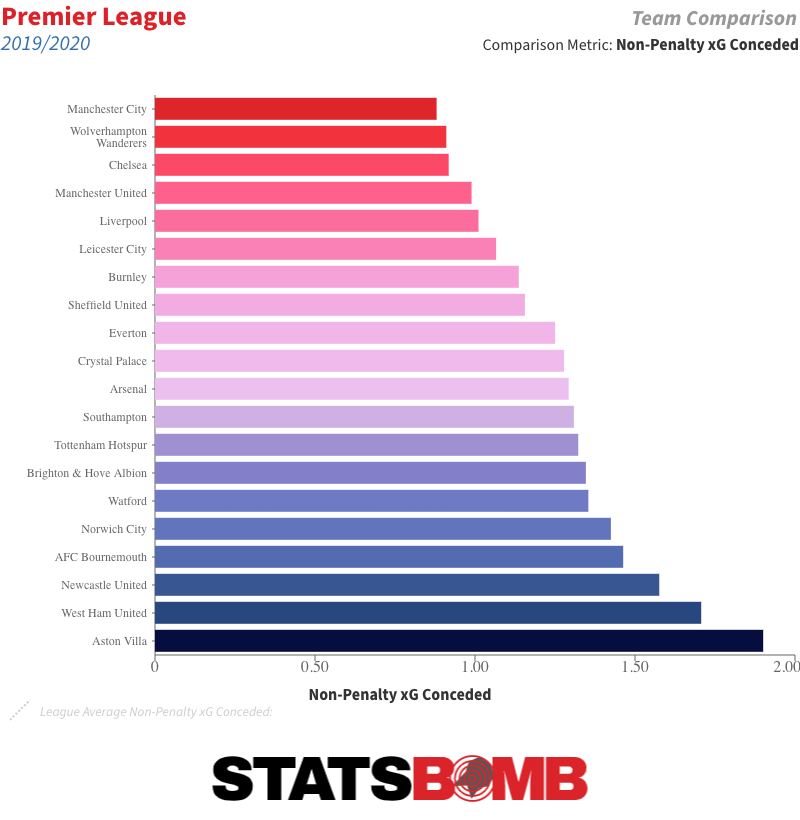 When your are conceding an average of two goals per match, you need your attack to be pretty damn good. Villa’s is only okay. They do, though, have a game in hand over those around them. Then comes the real action, four teams separated by just two points: Bournemouth, Watford, West Ham and Brighton. It is an incredibly hard race to call, and in truth, it wouldn’t be all that surprising if a similar number of points covered them come the end of the campaign. Watford have the momentum. Since Nigel Pearson became their third head coach of the season in early December, they’ve matched top-half results to top-half underlying numbers. There has been clear improvement, especially in defence.
When your are conceding an average of two goals per match, you need your attack to be pretty damn good. Villa’s is only okay. They do, though, have a game in hand over those around them. Then comes the real action, four teams separated by just two points: Bournemouth, Watford, West Ham and Brighton. It is an incredibly hard race to call, and in truth, it wouldn’t be all that surprising if a similar number of points covered them come the end of the campaign. Watford have the momentum. Since Nigel Pearson became their third head coach of the season in early December, they’ve matched top-half results to top-half underlying numbers. There has been clear improvement, especially in defence. 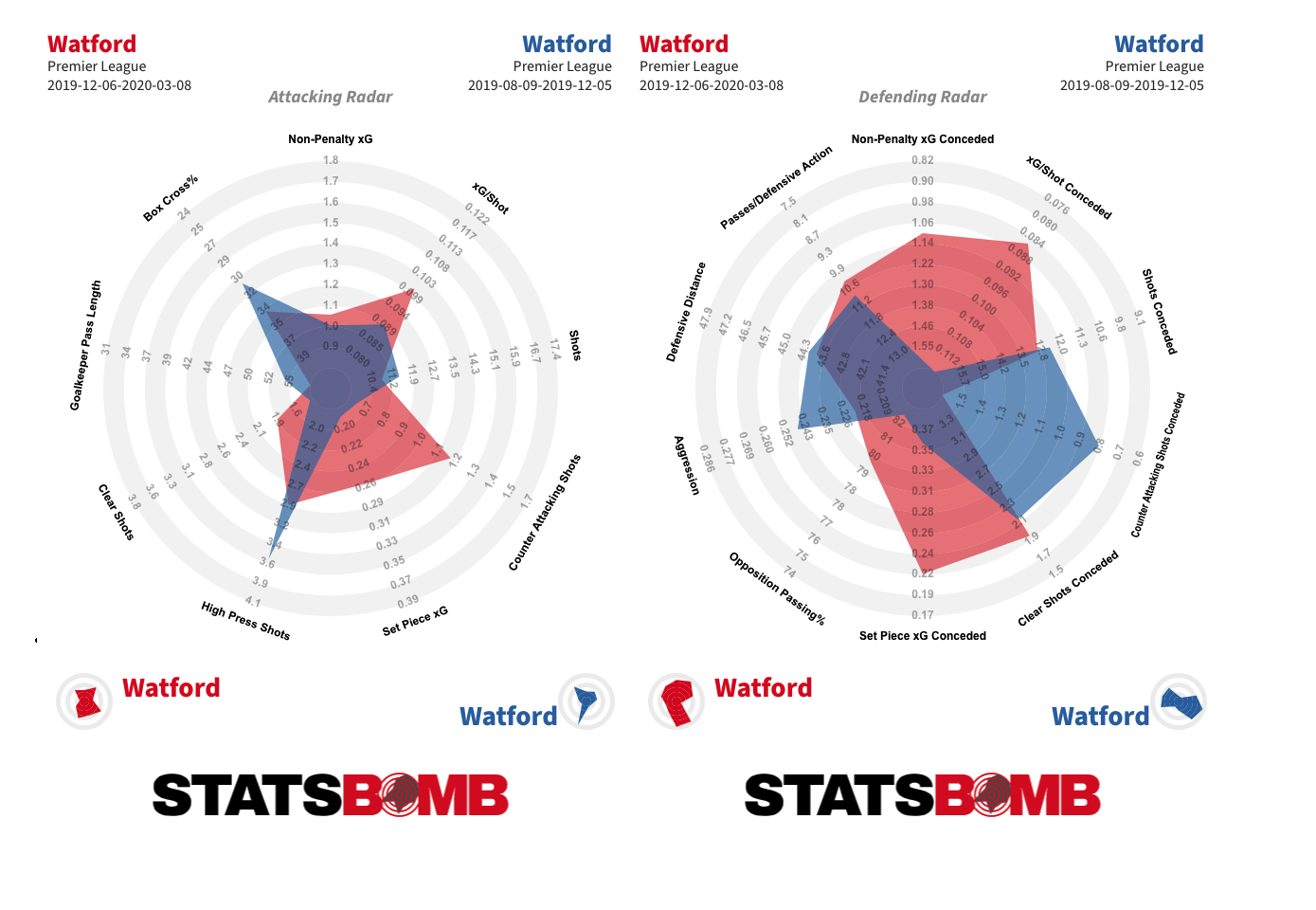 David Moyes has not yet had the same effect at West Ham. Results and underlying numbers have actually got marginally worse there since he replaced Manuel Pellegrini at the end of December. The stylistic changes are clear: deeper and more passive defending, and a greater reliance on transitional phases to create shots. The end result is all but unchanged.
David Moyes has not yet had the same effect at West Ham. Results and underlying numbers have actually got marginally worse there since he replaced Manuel Pellegrini at the end of December. The stylistic changes are clear: deeper and more passive defending, and a greater reliance on transitional phases to create shots. The end result is all but unchanged. 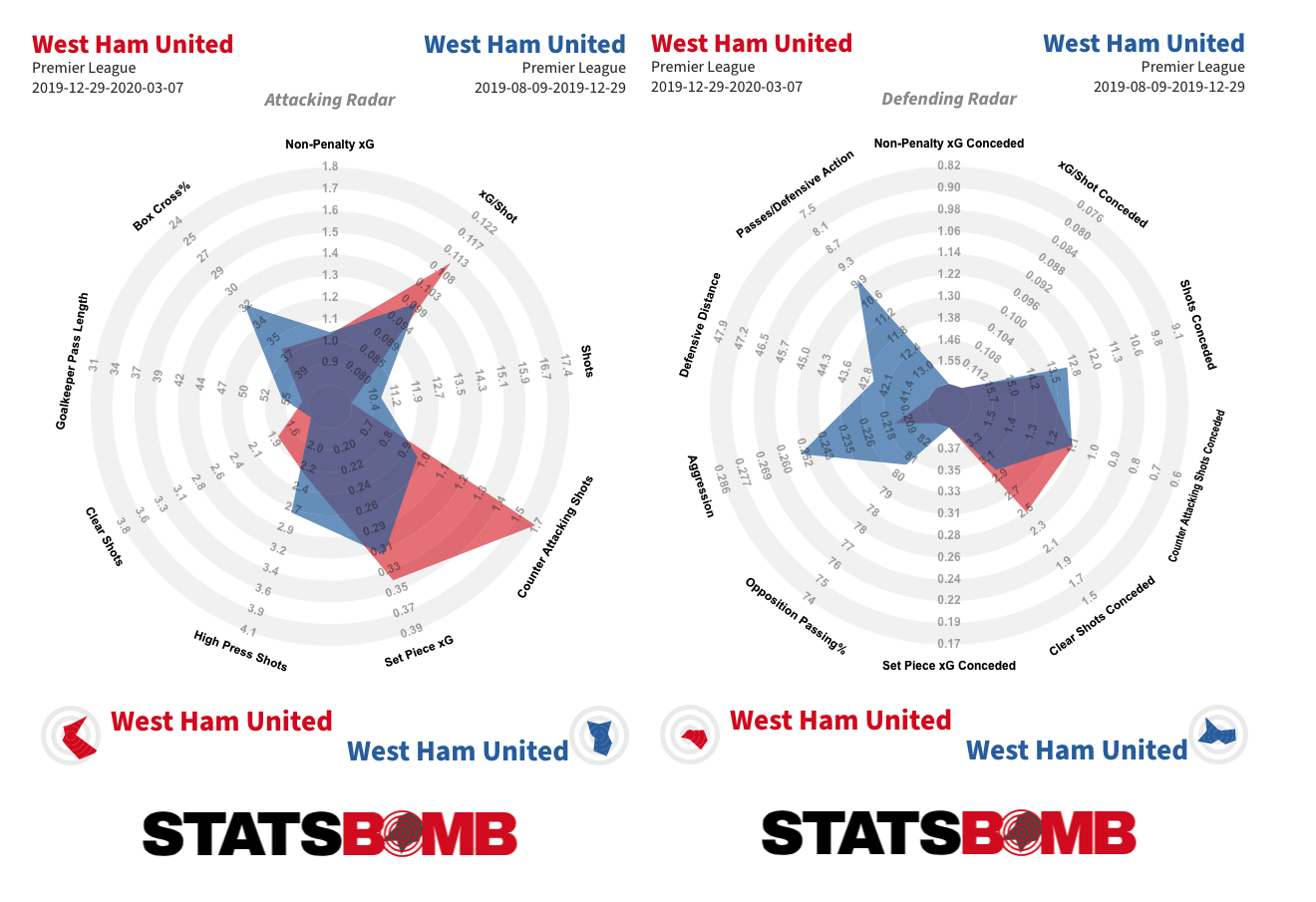 Bournemouth are one of the worst six teams by the underlying numbers and slipped into the bottom three off the back of three defeats and a draw prior to the league stoppage. They don’t inspire a great deal of confidence at either end of the pitch, and may have to lean on their
Bournemouth are one of the worst six teams by the underlying numbers and slipped into the bottom three off the back of three defeats and a draw prior to the league stoppage. They don’t inspire a great deal of confidence at either end of the pitch, and may have to lean on their 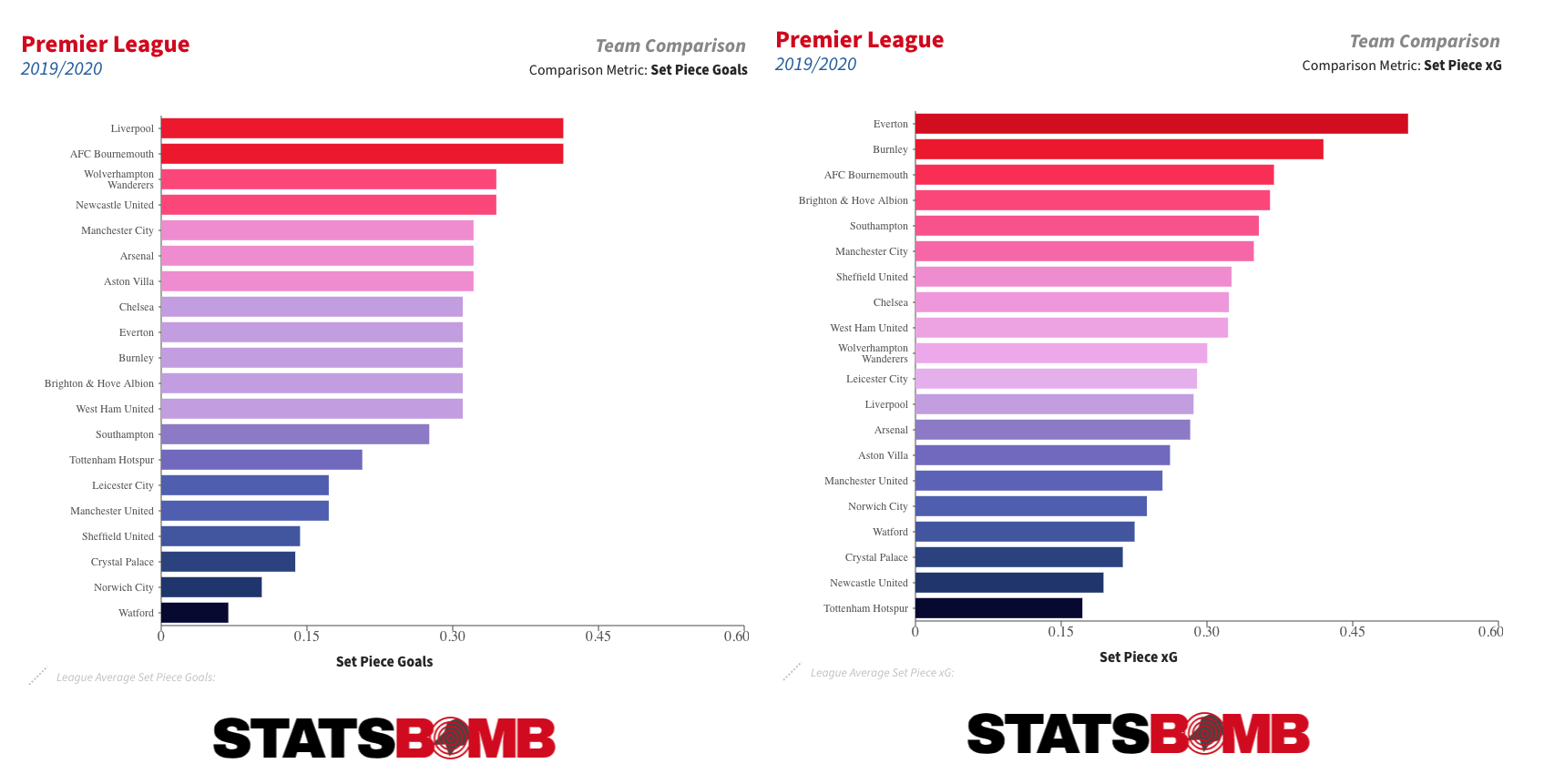 Brighton are yet to win a match this calendar year, and in fact have won only once in their last 14. No team have taken fewer points in 2020. While it is fairly easy to
Brighton are yet to win a match this calendar year, and in fact have won only once in their last 14. No team have taken fewer points in 2020. While it is fairly easy to 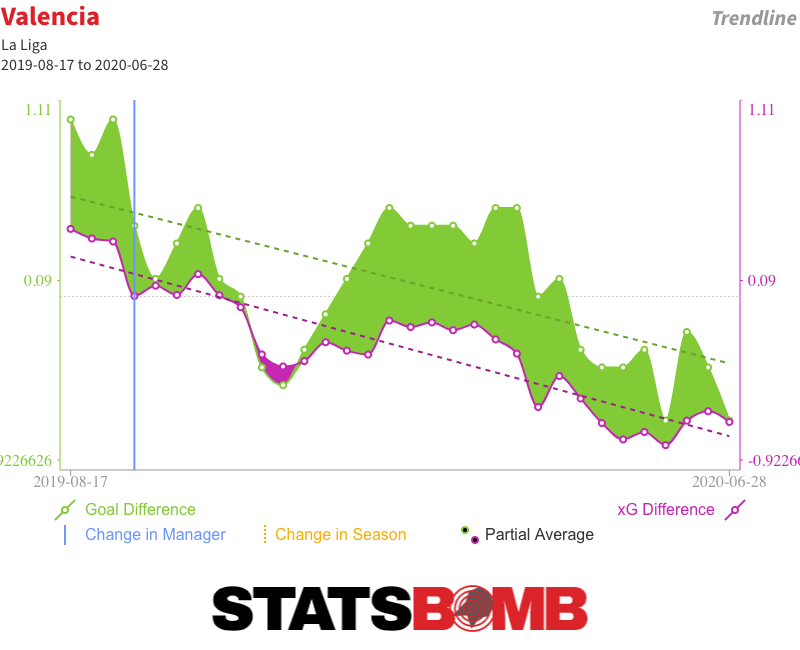
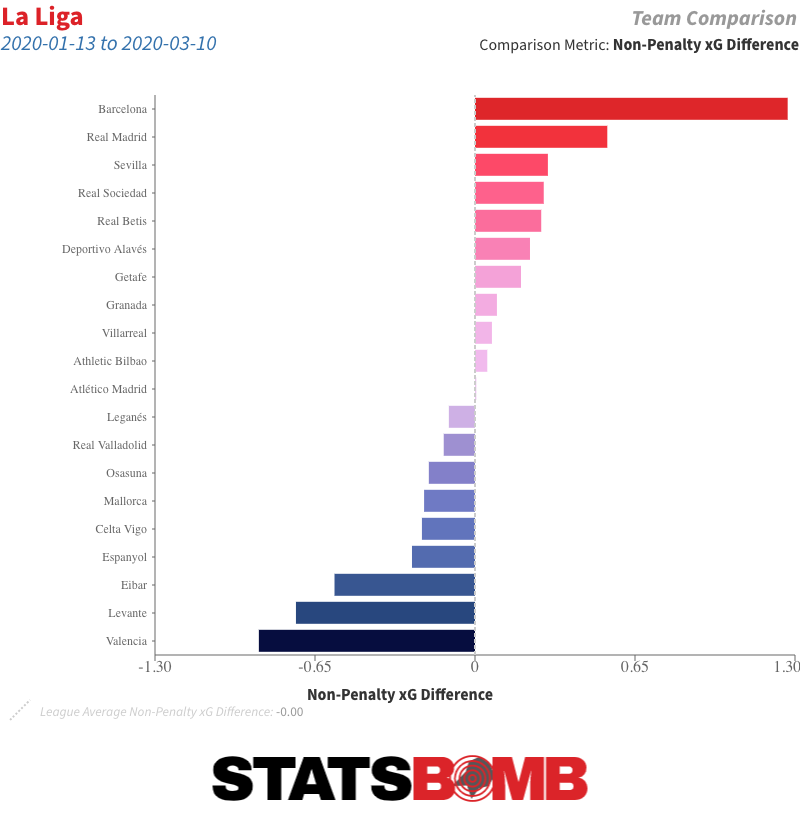 Setién’s heavily possession-based style should also be a good fit for the hectic fixture list that, if everything runs smoothly, will see the teams play their remaining 11 matches over the course of just over five weeks of action. There are some counterpoints. On paper, Madrid look to have the easier run-in. The pause has also given Eden Hazard the opportunity to recover from what seemed likely to be a season-ending injury. With Marco Asensio likewise closing in on a return, Madrid look better equipped than they might otherwise have been to go toe-to-toe for the title. European Places The contest for the two remaining Champions League places will be a thrilling watch. Just two points currently span Sevilla in third, Real Sociedad in fourth, Getafe in fifth and Atlético Madrid in sixth. Sevilla possibly have a slight edge. January signings
Setién’s heavily possession-based style should also be a good fit for the hectic fixture list that, if everything runs smoothly, will see the teams play their remaining 11 matches over the course of just over five weeks of action. There are some counterpoints. On paper, Madrid look to have the easier run-in. The pause has also given Eden Hazard the opportunity to recover from what seemed likely to be a season-ending injury. With Marco Asensio likewise closing in on a return, Madrid look better equipped than they might otherwise have been to go toe-to-toe for the title. European Places The contest for the two remaining Champions League places will be a thrilling watch. Just two points currently span Sevilla in third, Real Sociedad in fourth, Getafe in fifth and Atlético Madrid in sixth. Sevilla possibly have a slight edge. January signings 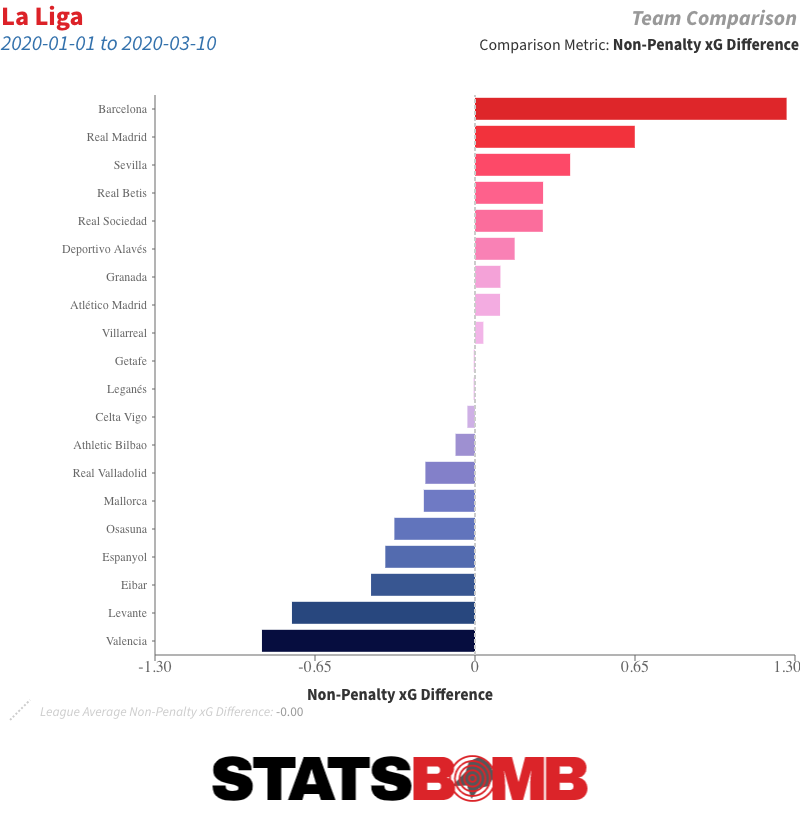 But this is a very difficult race to call. Real Sociedad have won admirers as a young and vibrant team playing attractive football, but they look to have the toughest schedule of any of the top-four aspirants. Getafe have been on a tear since the turn of the year, but can they maintain their intense play style through the crammed fixture list? With their
But this is a very difficult race to call. Real Sociedad have won admirers as a young and vibrant team playing attractive football, but they look to have the toughest schedule of any of the top-four aspirants. Getafe have been on a tear since the turn of the year, but can they maintain their intense play style through the crammed fixture list? With their 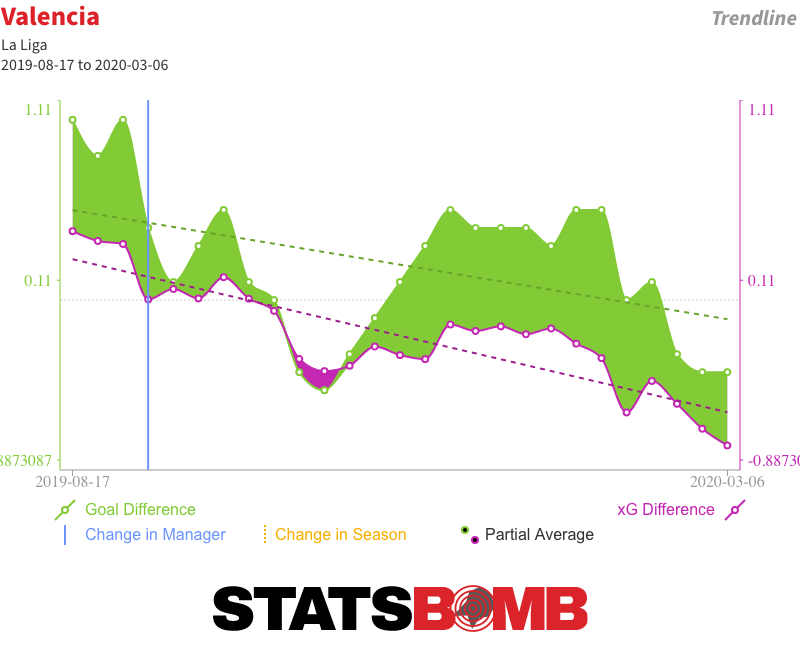 Valencia’s numbers are trending in the wrong direction, and it seems improbable that a team taking less than nine shots a match while conceding nearly 15 can continue to get the results necessary to keep pace with those ahead. In fact, their seventh place, a position that could yield a Europa League spot depending on the outcomes of domestic and continental cup competitions, could come under threat from behind. Villarreal have been frustratingly inconsistent but have enough quality in attack to make up the four-point difference if things go their way. Granada have impressed on their return to the top flight and made a good start to 2020. But that’s probably it. Athletic Club have one of the best defensive records in the league but their attacking output is below average, and they’ve benefited from a positive swing versus their underlying numbers. They’ve also taken just 11 points from their last 12 fixtures. The Copa del Rey final against Basque rivals Real Sociedad would seem to offer their best hope of European qualification. Relegation There are three relegation places to be filled and six teams trying to avoid them. While there is still an outside chance that Alavés or Levante might get dragged into it, the battle against the drop is likely to be contested by Espanyol, Leganés, Mallorca, Celta Vigo, Eibar and Real Valladolid. Espanyol are bottom of the pile. Results have improved considerably since Abelardo became their third head coach of the campaign late into December, but there hasn’t been an
Valencia’s numbers are trending in the wrong direction, and it seems improbable that a team taking less than nine shots a match while conceding nearly 15 can continue to get the results necessary to keep pace with those ahead. In fact, their seventh place, a position that could yield a Europa League spot depending on the outcomes of domestic and continental cup competitions, could come under threat from behind. Villarreal have been frustratingly inconsistent but have enough quality in attack to make up the four-point difference if things go their way. Granada have impressed on their return to the top flight and made a good start to 2020. But that’s probably it. Athletic Club have one of the best defensive records in the league but their attacking output is below average, and they’ve benefited from a positive swing versus their underlying numbers. They’ve also taken just 11 points from their last 12 fixtures. The Copa del Rey final against Basque rivals Real Sociedad would seem to offer their best hope of European qualification. Relegation There are three relegation places to be filled and six teams trying to avoid them. While there is still an outside chance that Alavés or Levante might get dragged into it, the battle against the drop is likely to be contested by Espanyol, Leganés, Mallorca, Celta Vigo, Eibar and Real Valladolid. Espanyol are bottom of the pile. Results have improved considerably since Abelardo became their third head coach of the campaign late into December, but there hasn’t been an 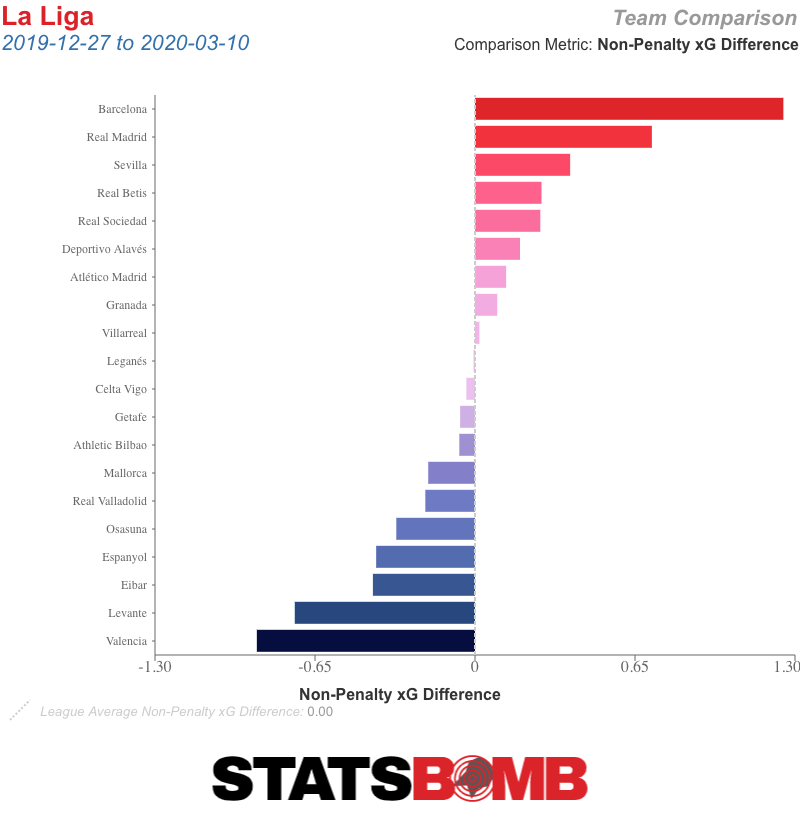 With other teams towards the foot of the table also picking up good points in the lead up to the league stoppage, they are still six points shy of safety. All is not lost. There is still over a quarter of the campaign to be played. But Espanyol are not in a good position right now. Second from bottom are Leganés. They’ve had mid-table underlying numbers all season but have consistently underperformed those numbers at both ends of the pitch.
With other teams towards the foot of the table also picking up good points in the lead up to the league stoppage, they are still six points shy of safety. All is not lost. There is still over a quarter of the campaign to be played. But Espanyol are not in a good position right now. Second from bottom are Leganés. They’ve had mid-table underlying numbers all season but have consistently underperformed those numbers at both ends of the pitch.  Their luck may yet turn, but the January departures of En-Nesyri and Martin Braithwaite, between them scorers of almost half of their league-low tally of 21 goals, certainly didn’t help their cause. Next up are Mallorca, Celta Vigo and Eibar, all separated by just two points between 18th and 16th. Mallorca have shown signs of improvement since the turn of the year, particularly in defence, but they have one of the hardest closing schedules and a thin squad. Things look brighter for Celta Vigo, who have been
Their luck may yet turn, but the January departures of En-Nesyri and Martin Braithwaite, between them scorers of almost half of their league-low tally of 21 goals, certainly didn’t help their cause. Next up are Mallorca, Celta Vigo and Eibar, all separated by just two points between 18th and 16th. Mallorca have shown signs of improvement since the turn of the year, particularly in defence, but they have one of the hardest closing schedules and a thin squad. Things look brighter for Celta Vigo, who have been 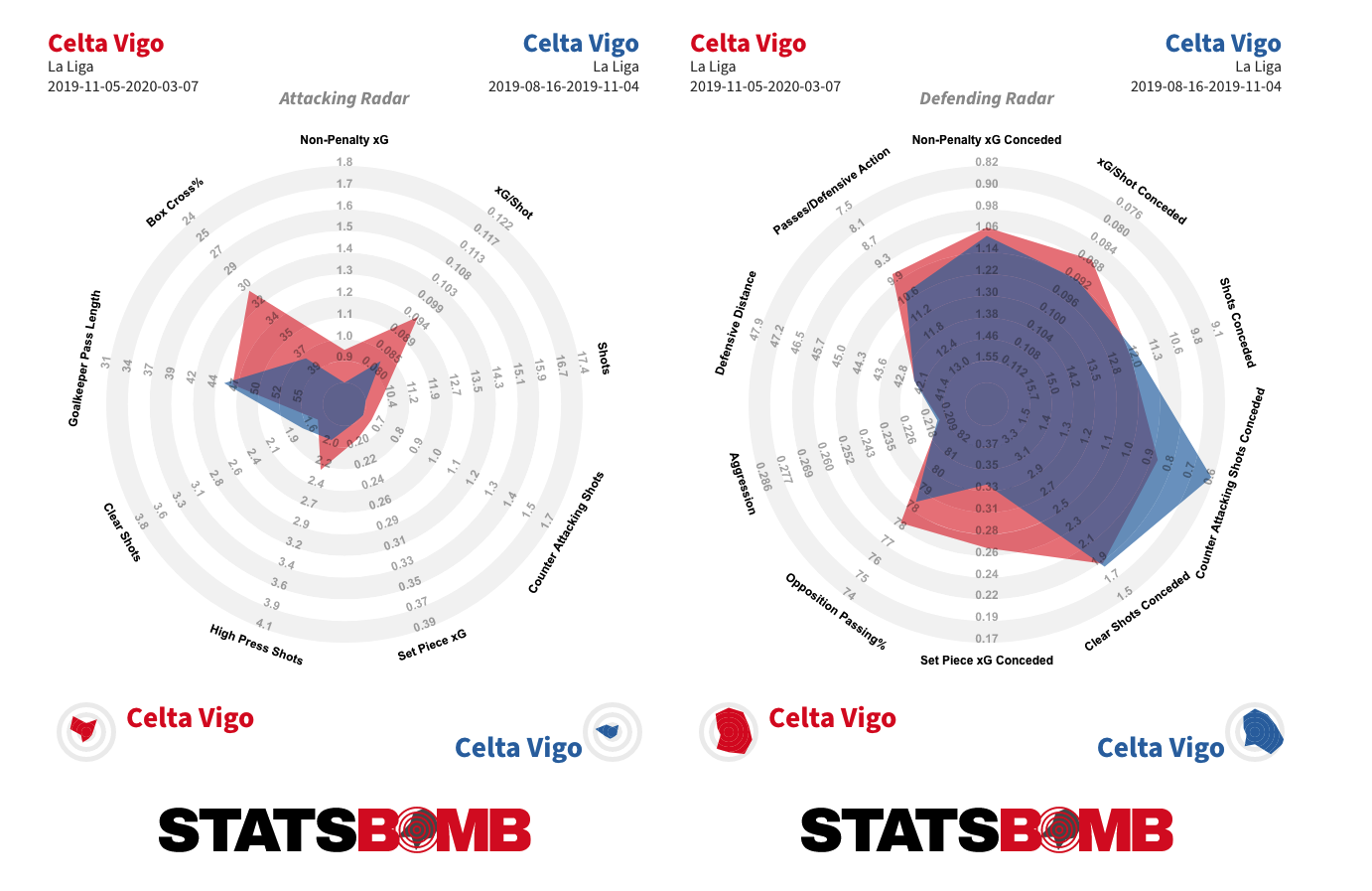 Eibar might be in trouble. While they’ve improved upon their pitiful early season performances, they’ve still been one of the worst three teams in the division by the underlying numbers since the turn of the year. A combination of the league’s oldest squad and an aggressive play style is unlikely to mesh well with the condensed schedule. Valladolid have a four-point cushion over the last relegation place. While they are far from home and dry, if they can continue to pick up points at their current rate -- which seems doable considering they are performing pretty much exactly in line with their underlying numbers -- it is unlikely that three teams will overtake them.
Eibar might be in trouble. While they’ve improved upon their pitiful early season performances, they’ve still been one of the worst three teams in the division by the underlying numbers since the turn of the year. A combination of the league’s oldest squad and an aggressive play style is unlikely to mesh well with the condensed schedule. Valladolid have a four-point cushion over the last relegation place. While they are far from home and dry, if they can continue to pick up points at their current rate -- which seems doable considering they are performing pretty much exactly in line with their underlying numbers -- it is unlikely that three teams will overtake them.